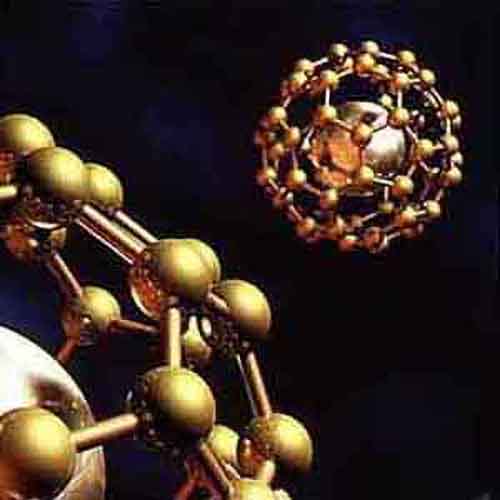
Anunnaki
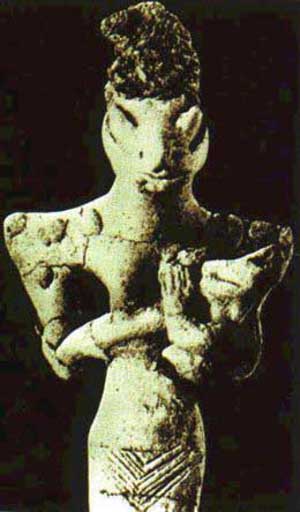
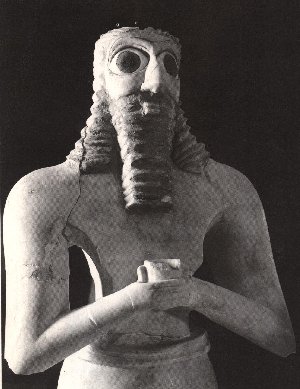
Is Anu holding the symbolic Holy Grail of a Bloodline he created?
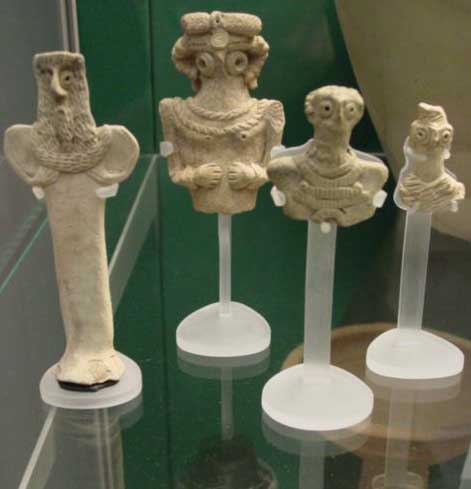
British Museum
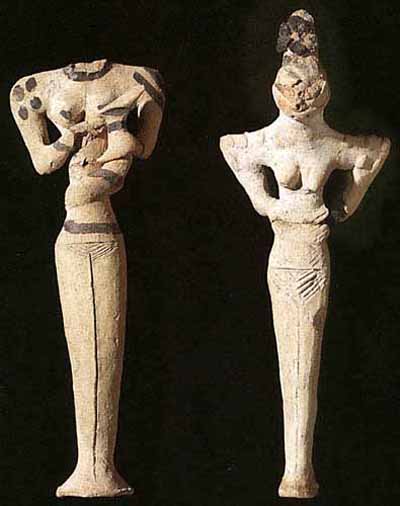
The Anunnaki are a group of deities in ancient Mesopotamian cultures (i.e. Sumerian, Akkadian, Assyrian, and Babylonian). The name allegedly means something to the effect of "those of royal blood" or "princely offspring". A widespread late but probably false etymology is that the name derived from the union of heaven (Anu) with the earth (Ki).
A widespread late but probably false etymology is that the name derived from the union of heaven (Anu) with the earth (Ki). Their relation to the group of gods known as the Igigi is unclear - at times the names are used synonymously but in the Atra-Hasis flood myth the Igigi are the sixth generation of the Gods who have to work for the Anunnaki, rebelling after 40 days and replaced by the creation of humans.
- Igigi was a term used to refer to the gods of heaven in Sumerian mythology. Though sometimes synonymous with the term "Annunaki," in one myth the Igigi were the younger gods who were servants of the Annunaki, until they rebelled and were replaced by the creation of humans.
The Annunaki are mentioned in The Epic of Gilgamesh when Utnapishtim tells the story of the flood. The seven judges of hell are called the Annunaki, and they set the land aflame as the storm is approaching.
According to later Assyrian and Babylonian myth, the Anunnaki were the children of Anu and Ki, brother and sister gods, themselves the children of Anshar and Kishar (Skypivot and Earthpivot, the Celestial poles), who in turn were the children of Lahamu and Lahmu ("the muddy ones"), names given to the gatekeepers of the Abzu (House of Far Waters) temple at Eridu, the site at which the creation was thought to have occurred. Finally, Lahamu and Lahmu were the children of Tiamat (Goddess of the Ocean) and Abzu (God of Fresh Water).
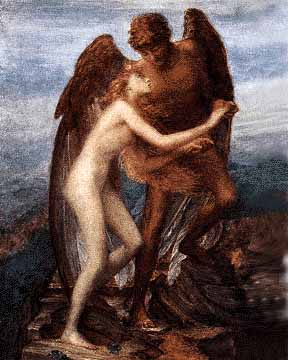 Nephilim, Anunnaki - Royal Bloodline - Creators
Nephilim, Anunnaki - Royal Bloodline - Creators"Those who from Heaven to Earth came"
In Sumerian Mythology the Anunnaki were a pantheon of good and evil gods and goddesses (duality) who came to Earth to create the human race. According to the some resources, these gods came from Nibiru - 'Planet of the Crossing.' The Assyrians and Babylonians called it 'Marduk', after their chief god. Sumerians said one year on planet Nibiru, a sar, was equivalent in time to 3,600 Earth years. Anunnaki lifespans were 120 sars which is 120 x 3,600 or 432,000 years. According to the King List - 120 sars had passed from the time the Anunnaki arrived on Earth to the time of the Great Flood.
Creating Bloodlines
Physical evidence of ancient astronauts is found throughout the planet, leading one to conclude that different races visited here at different periods in Earth's history, or the same aliens return and set up various programs (civilizations) in which they could remain and experience.
These would include:
- Middle East,Egypt,
India,
China,
Greece,
Mesoamerica,
other Ancient Civilizations
Mythical Civilizations
The Alien in the Stargate
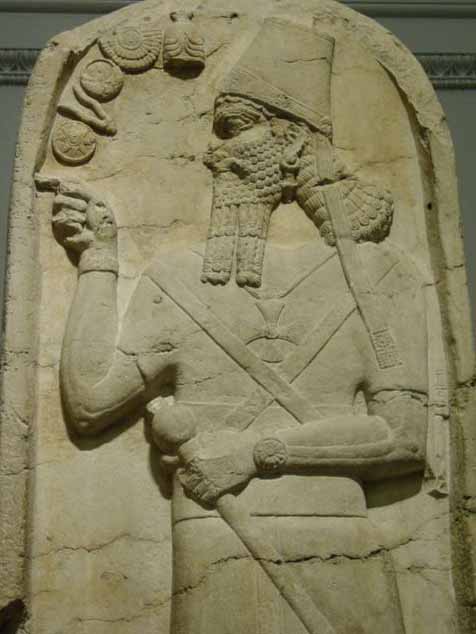
The entity wears a bird-headed mask and feels feminine.
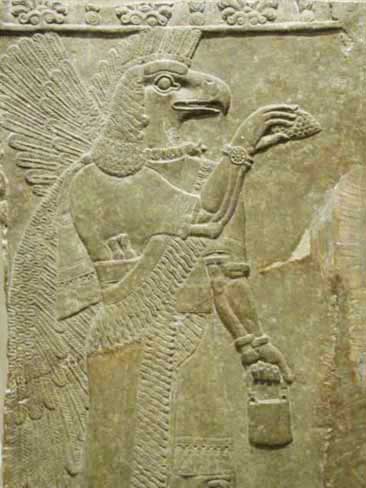
Both arms have wrist devices used for time travel,
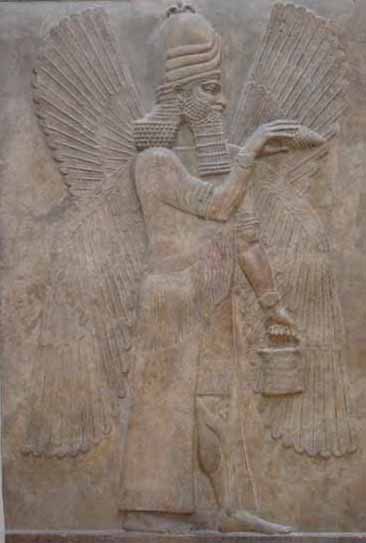
encoding grids, teleportation and communication.
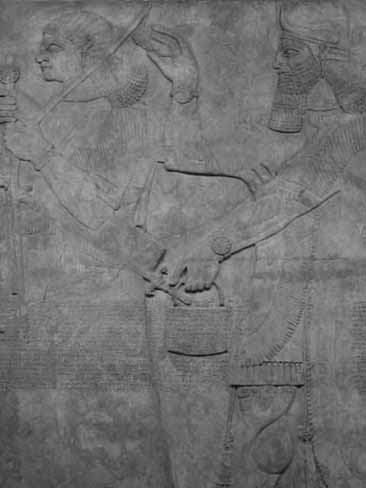
Creation by sound
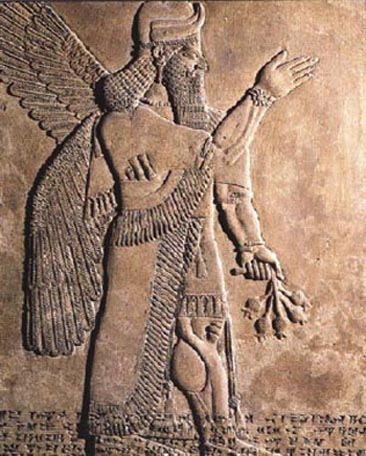
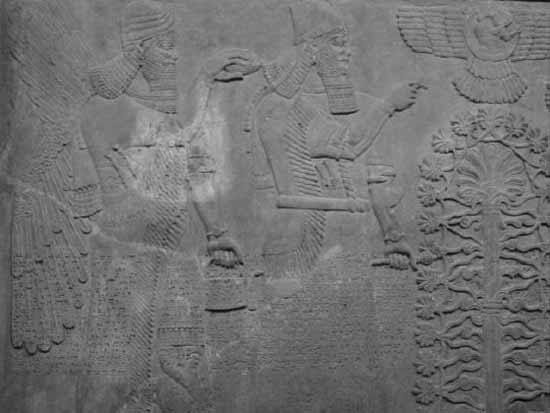
Qabbalah Tree of Life
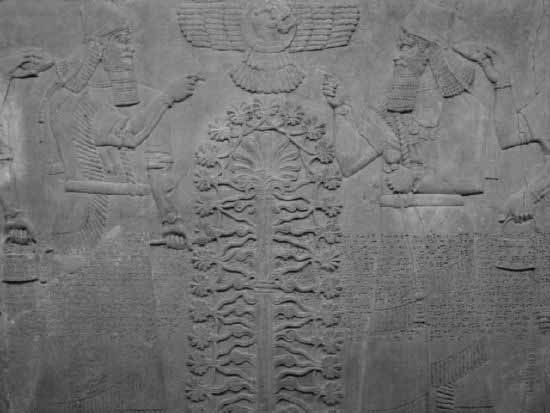
Sacred Geometry and Consciousness
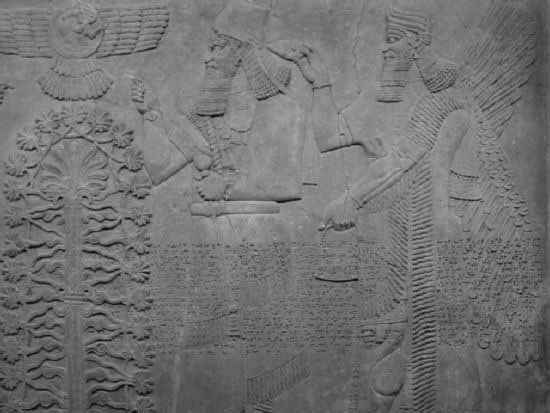
Ahura Madza - Overseer of Earth - Higher Extraterrestrial Intelligence
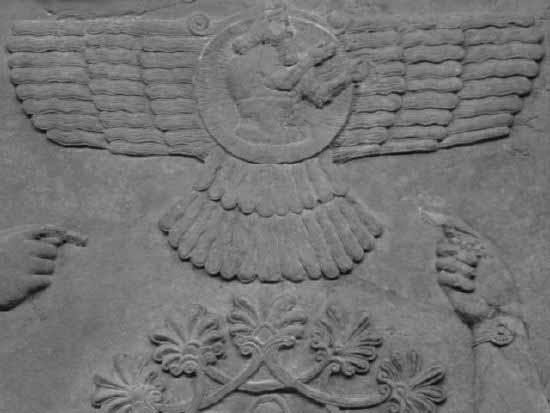
Zoroaster
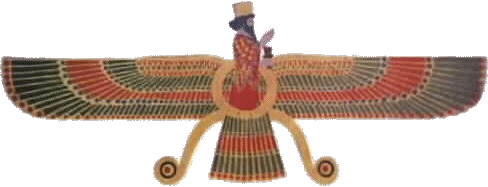

The Lion's Tail - Sphinx -- Sophia -- Male or Female?
The Four Primary Gods
Enki
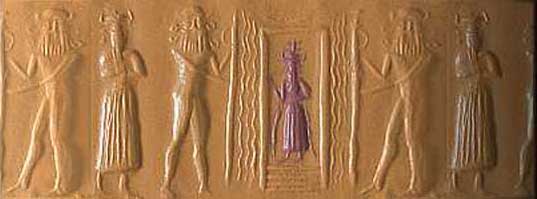
Ea stands in his watery home the Apsu.
Enki walks out of the water to the land attended by his messenger, Isimud
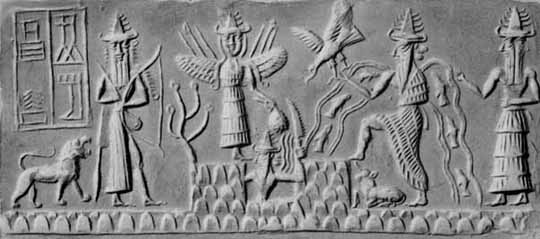
who is readily identifiable by his two faces looking in opposite directions (duality).
Enki stands with the Gods and the Initiate
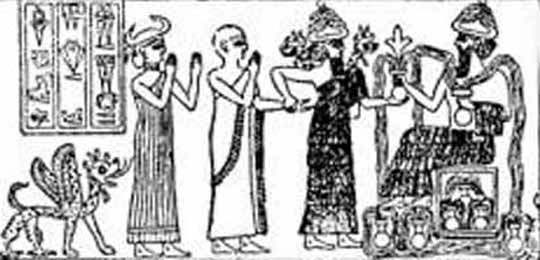
Water of Life flowing into the laboratory glassware indicates alchemical circulations.
The creation of the first human
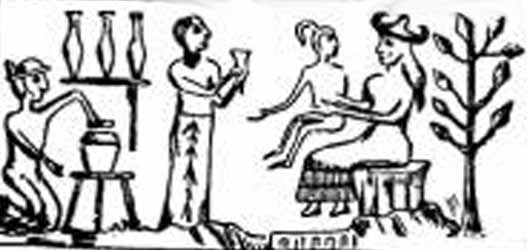
Laboratory vessels symbolize the bloodline and the Tree of Life.
Handing the water/liquid/blood of life
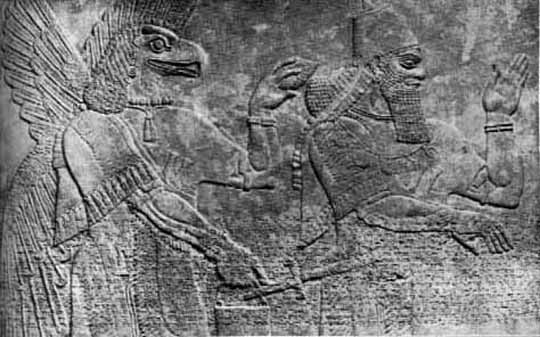
to a bio-genetically engineered human. Humans are a hybrid species.
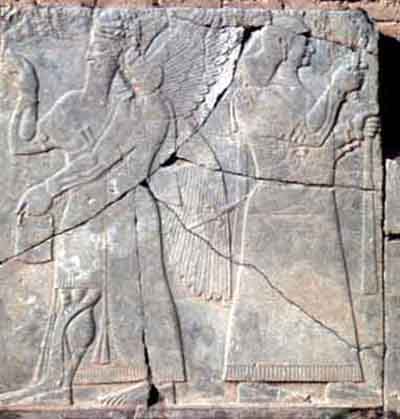
Ea
Enki was a deity in Sumerian mythology, later known as Ea in Babylonian mythology. The name Ea is of Sumerian origin and was written by means of two signs signifying "house" and "water". Enki was the deity of water, intelligence, creation, and lord of the Apsu, the watery abyss.
Creation Myths
The main temple of Enki was the so-called e-engur-ra, the "house of the water-deep" in Eridu, which was in the wetlands of the Euphrates valley at some distance from the Persian Gulf - the Cradle of Civilization. His name is possibly an epithet bestowed on him for the creation of the first man, Adamu or Adapa.
He was the leader of the first sons of Anu who came down to Earth, playing a pivotal role in creating humans then saving them from the Deluge. According to Sumerian mythology, Enki allowed humanity to survive the Deluge designed to kill them. After Enlil and the rest of the Anunnaki, decided that Man would suffer total annihilation, he covertly rescued the human man Ziusudra by either instructing him to build some kind of an boat for his family, or by bringing him into the heavens in a magic boat. This is apparently the oldest surviving source of the Noah's Ark myth and other parallel Middle Eastern Deluge myths.
Flood Myths
Linked to flood myths, Enki was considered a god of life and replenishment, and was often depicted with streams of water emanating from his shoulders. Alongside him were trees symbolizing the male and female aspects of nature, each holding the male and female aspects of the 'Life Essence', which he, as apparent alchemist of the gods, would masterfully mix to create several beings that would live upon the face of the Earth.
Family
Enki's youngest son, Ningizzida, was Lord of the Tree of Truth, in Mesopotamia and played the role of Thoth in Egypt. The ancient Mystery School Teachings of Thoth were past down to his Initiates who became the priests. They hid the secret knowledge of creation, passing it down through the ages until their experiment was to end.
Symbols
Enki's emblem was two serpents entwined on a staff - the basis for the winged caduceus symbol used by modern Western medicine and the rod of Hermes. His symbols included a goat and a fish, which later combined into a single beast, the Capricorn, which became one of the signs of the zodiac. Enki's sacred number is 40.
Me
He was the keeper of the holy powers called Me. The exact meaning of his name is not sure: the common translation is "Lord of the Earth": the Sumerian en is translated as "lord", ki as "earth"; but there are theories that ki in this name has another origin.
Apsu
Eridu, meaning "the good city", was one of the oldest settlements in the Euphrates valley, and is now represented by the mounds known as Abu Shahrein. In the absence of excavations on that site, we are dependent for our knowledge of Ea on material found elsewhere. This is, however, sufficient to enable us to state definitely that Ea was a water-deity, lord especially of the water under the earth, the Apsu. Whether Ea (or A-e as some scholars prefer) represents the real pronunciation of his name we do not know.
Older accounts sometimes suppose that by reason of the constant accumulation of soil in the Euphrates valley Eridu was formerly situated on the Persian Gulf itself (as indicated by mention in Sumerian texts of its being on the Apsu), but it is now known that the opposite is true, that the waters of the Persian Gulf have been eroding the land and that the Apsu must refer to the fresh water of the marshes surrounding the city.
Eridu
Whether Eridu at one time also played an important political role is not certain, though not improbable. At all events, the prominence of the Ea cult led, as in the case of Nippur, to the survival of Eridu as a sacred city, long after it had ceased to have any significance as a political center. Myths in which Ea figures prominently have been found in Assurbanipal's library, indicating that Ea was regarded as the protector and teacher of mankind. He is essentially a god of civilization, and it was natural that he was also looked upon as the creator of man, and of the world in general.
Traces of this view appear in the Marduk epic celebrating the achievements of this god, and the close connection between the Ea cult at Eridu and that of Marduk also follows from two considerations:
- the name of Marduk's sanctuary at Babylon bears the same name, Esaggila, as that of Ea in Eridu
- Marduk is generally termed the son of Ea, who derives his powers from the voluntary abdication of the father in favor of his son.
It is, however, more particularly as the third figure in the triad, the two other members of which were Anu and Enlil, that Ea acquires his permanent place in the pantheon. To him was assigned the control of the watery element, and in this capacity he becomes the shar apsi, i.e. king of the Apsu or "the deep." The Apsu was figured as the abyss of water beneath the earth, and since the gathering place of the dead, known as Aralu, was situated near the confines of the Apsu, he was also designated as En-Ki, i.e. "lord of that which is below", in contrast to Anu, who was the lord of the "above" or the heavens.
The cult of Ea extended throughout Babylonia and Assyria. We find temples and shrines erected in his honor, e.g. at Nippur, Girsu, Ur, Babylon, Sippar and Nineveh, and the numerous epithets given to him, as well as the various forms under which the god appears, alike bear witness to the popularity which he enjoyed from the earliest to the latest period of Babylonian-Assyrian history.
An - Anu


In Sumerian mythology and later for Assyrians and Babylonians, Anu was a sky-god, the god of heaven, lord of constellations, king of gods, spirits and demons, and dwelt in the highest heavenly regions. It was believed that he had the power to judge those who had committed crimes, and that he had created the stars as soldiers to destroy the wicked. He was the father of the Anunnaki. In art he was sometimes depicted as a jackal. His attribute was the royal tiara, most times decorated with two pairs of bull horns.
In Sumerian mythology, An was the god whose name was synonymous with the sun's zenith, or heaven. He was the oldest god in the Sumerian pantheon, and part of a triad including Enlil, god of the sky and Enki, god of water. He was called Anu by the Akkadians, rulers of Mesopotamia after the conquest of Sumer in 2334 BCE by King Sargon of Akkad.
In Sumerian mythology and later for Assyrians and Babylonians, Anu was a sky-god, the god of heaven, lord of constellations, king of gods, spirits and demons, and dwelt in the highest heavenly regions. It was believed that he had the power to judge those who had committed crimes, and that he had created the stars as soldiers to destroy the wicked. In art he was sometimes depicted as a jackal (linked with Mesoamerican gods). His attribute was the royal tiara, most times decorated with two pairs of bull horns.
By virtue of being the first figure in a triad consisting of Anu, Bel and Ea, Anu came to be regarded as the father and king of the gods. Anu is so prominently associated with the city of Erech in southern Babylonia that there are good reasons for believing this place to have been the original seat of the Anu cult. If this be correct, then the goddess Nana (or Ishtar) of Erech was presumably regarded as his consort.
The name of the god signifies the "high one" and he was probably a god of the atmospheric region above the earth--perhaps a storm god like Adad. However this may be, already in the old-Babylonian period, i.e. before Khammurabi, Anu was regarded as the god of the heavens and his name became in fact synonymous with the heavens, so that in some cases it is doubtful whether, under the term, the god or the heavens is meant.
It would seem from this that the grouping of the divine powers recognized in the universe into a triad symbolizing the three divisions, heavens, earth and the watery-deep, was a process of thought which had taken place before the third millennium.
To Anu was assigned the control of the heavens, to Bel the earth, and to Ea the waters.
The doctrine once established remained an inherent part of the Babylonian-Assyrian religion and led to the more or less complete disassociation of the three gods constituting the triad from their original local limitations.
An intermediate step between Anu viewed as the local deity of Erech (or some other centre), Bel as the god of Nippur, and Ea as the god of Eridu is represented by the prominence which each one of the centers associated with the three deities in question must have acquired, and which led to each one absorbing the qualities of other gods so as to give them a controlling position in an organized pantheon.
For Nippur we have the direct evidence that its chief deity, En-lil or Bel, was once regarded as the head of an extensive pantheon. The sanctity and, therefore, the importance of Eridu remained a fixed tradition in the minds of the people to the latest days, and analogy therefore justifies the conclusion that Anu was likewise worshipped in a centre which had acquired great prominence.
The summing-up of divine powers manifested in the universe in a threefold division represents an outcome of speculation in the schools attached to the temples of Babylonia, but the selection of Anu, Bel and Ea for the three representatives of the three spheres recognized, is due to the importance which, for one reason or the other, the centers in which Anu, Bel and Ea were worshipped had acquired in the popular mind.
Each of the three must have been regarded in his centre as the most important member in a larger or smaller group, so that their union in a triad marks also the combination of the three distinctive pantheons into a harmonious whole. In the astral theology of Babylonia and Assyria, Anu, Bel and Ea became the three zones of the ecliptic, the northern, middle and southern zone respectively.
The purely theoretical character of Anu is thus still further emphasized, and in the annals and votive inscriptions as well as in the incantations and hymns, he is rarely introduced as an active force to whom a personal appeal can be made. His name becomes little more than a synonym for the heavens in general and even his title as king or father of the gods has little of the personal element in it.
In Hurrian mythology, Anu was the progenitor of all gods. His son Kumarbi bit off his genitals and spat out three deities, one of whom, Teshub, later deposed Kumarbi. He bit off the genitals of Anu and spat out three new gods. One of those, the storm god Teshub, later deposed Kumarbi. Scholars have pointed to the remarkable similarities between this Hurrian creation myth and the story of Ouranos, Kronos, and Zeus from Greek mythology.
Ashur
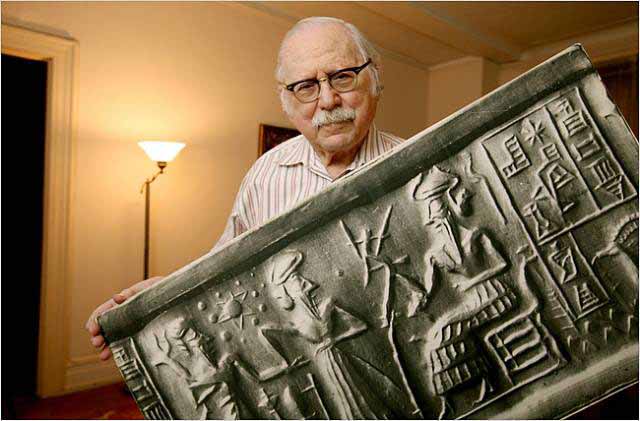
According to Sitchin, Nibiru - whose name was replaced with Marduk in original legends by the Babylonian ruler of the same name in an attempt to co-opt the creation for himself, leading to some confusion among readers - collided catastrophically with Tiamat a goddess in the Babylonian creation myth the Enuma Elish which he considers to be another planet once located between Mars and Jupiter. This collision supposedly formed the planet Earth, the asteroid belt, and the comets. Sitchin states that when struck by one of planet Nibiru's moons, Tiamat split in two, and then on a second pass Nibiru itself struck the broken fragments and one half of Tiamat became the asteroid belt. The second half, struck again by one of Nibiru's moons, was pushed into a new orbit and became today's planet Earth.
According to Sitchin, Nibiru - called "the twelfth planet" because, Sitchin claimed, the Sumerians' gods-given conception of the Solar System counted all eight planets, plus Pluto, the Sun and the Moon - was the home of a technologically advanced human-like extraterrestrial race called the Anunnaki in Sumerian myth and the Nephilim in Genesis. He wrote that they evolved after Nibiru entered the solar system and first arrived on Earth probably 450,000 years ago, looking for minerals, especially gold, which they found and mined in Africa. Sitchin states that these "gods" were the rank-and-file workers of the colonial expedition to Earth from planet Nibiru.
Sitchin wrote that Enki suggested that to relieve the Anunnaki, who had mutinied over their dissatisfaction with their working conditions, that primitive workers (Homo sapiens) be created by genetic engineering as slaves to replace them in the gold mines by crossing extraterrestrial genes with those of Homo erectus.
According to Sitchin, ancient inscriptions report that the human civilization in Sumer, Mesopotamia, was set up under the guidance of these "gods", and human kingship was inaugurated to provide intermediaries between mankind and the Anunnaki (creating the "divine right of kings" doctrine). Sitchin believed that fallout from nuclear weapons, used during a war between factions of the extraterrestrials, is the "evil wind" described in the Lament for Ur that destroyed Ur around 2000 BC. Sitchin states the exact year is 2024 BC. Sitchin says that his research coincides with many biblical texts, and that biblical texts come originally from Sumerian writings.
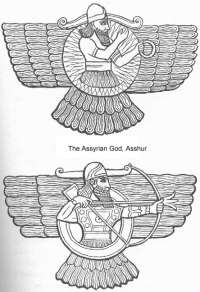
Winged Ashur is portrayed looking like the Faravahar or Zoroaster (Z).

Ninhursag- Ki
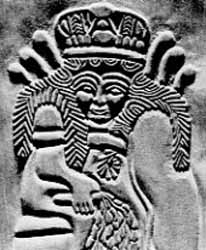

Milking scenes from the Temple of Ninhursag, - Tell al Ubaid, c. 2400 B.C.

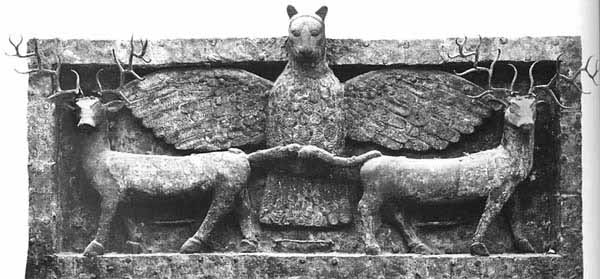
In Sumerian mythology, Ninhursag (or Ki) was the earth and mother-goddess she usually appears as the sister of Enlil. Ninhursag means 'Lady of the Foothills'. She had many other names: Nintur 'Lady Birth', Ninmah 'Lady August', Dingirmah, Aruru, and as wife of Enki was usually called Damgalnunna.
In Akkadian she was Belit-ili 'Lady of the Gods' and Mama and as wife to Ea, Enki's Akkadian counterpart, she was called Damkina. Her prestige decreased as Ishtar's increased, but her aspect as Damkina mother of Marduk, the supreme god of Babylonia, still held a secure place in the pantheon.
In union with Enki she also bore Ninsar, goddess of the pasture. She was the chief nurse, the one in charge of medical facilities. In that role that the Goddess was called NINTI (lady-life). She was considered the Mother Goddess. She was nicknamed 'Mammu' - now called 'mother' 'mom'.
Ninhursag bore a male child to Enlil. His name was NIN.UR.TA (lord who completes the fountain). He was the son who to do battle for his father using bolts of lightening.
In Egypt she played the roles of several creational goddesses - Isis, Maat and Hathor.
Enlil
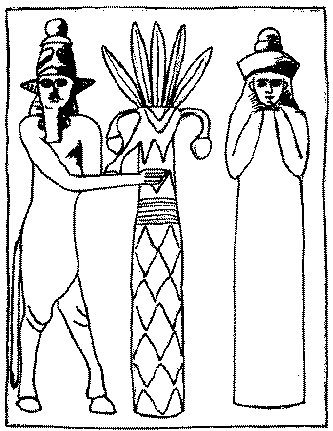
Enlil was the god of wind, or the sky between earth and heaven. One story has him originate as the exhausted breath of An (God of the heavens) and Ki (goddess of the Earth) after sexual union. Another accounts is that he and his sister Ninhursag/Ninmah/Aruru were children of an obscure god Enki 'Lord Earth' (not the famous Enki) by Ninki 'Lady Earth'.
When Enlil was a young god, he was banished from Dilmun, home of the gods, to Kur, the underworld for raping a young girl named Ninlil. Ninlil followed him to the underworld where she bore his first child, the moon god Sin. After fathering three more underworld deities, Enlil was allowed to return to Dilmun.
Enlil was also known as the inventor of the pickaxe/hoe (favorite tool of the Sumerians) and the cause of plants growing. He was in possession of the holy Me, until he gave them to Enki for safe keeping, who summarily lost them to Inanna in a drunken stupor.
Enlil's relation to An 'Sky', in theory the supreme god of the Sumerian pantheon, was somewhat like that of a Frankish mayor of the palace compared to the king, or that of a Japanese shogun compared to the emperor, or to a prime minister in a modern constitutional monarchy compared to the supposed monarch. While An was in name ruler in the highest heavens, it was Enlil who mostly did the actual ruling over the world.
By his wife Ninlil or Sud, Enlil was father of the moon god Nanna (in Akkadian Sin) and of Ninurta (also called Ningirsu). Enlil is sometimes father of Nergal, of Nisaba the goddess of grain, of Pabilsag who is sometimes equated with Ninurta, and sometimes of Enbilulu. By Ereshkigal Enlil was father of Namtar.
Enlil is associated with the ancient city of Nippur, and since Enlu with the determinative for "land" or "district" is a common method of writing the name of the city, it follows, apart from other evidence, that Enlil was originally the patron deity of Nippur.
At a very early period - prior to 3000 BC - Nippur had become the centre of a political district of considerable extent. Inscriptions found at Nippur, where extensive excavations were carried on during 1888-1900 by Messrs Peters and Haynes, under the auspices of the University of Pennsylvania, show that Enlil was the head of an extensive pantheon. Among the titles accorded to him are "king of lands," "king of heaven and earth" and "father of the gods".
His chief temple at Nippur was known as Ekur, signifying 'House of the mountain', and such was the sanctity acquired by this edifice that Babylonian and Assyrian rulers, down to the latest days, vied with one another in embellishing and restoring Enlil's seat of worship, and the name Ekur became the designation of a temple in general.
Grouped around the main sanctuary, there arose temples and chapels to the gods and goddesses who formed his court, so that Ekur became the name for an entire sacred precinct in the city of Nippur.
The name "mountain house" suggests a lofty structure and was perhaps the designation originally of the staged tower at Nippur, built in imitation of a mountain, with the sacred shrine of the god on the top.
When, with the political rise of Babylon as the centre of a great empire, Nippur yielded its prerogatives to the city over which Marduk presided, the attributes and the titles of Enlil were largely transferred to Marduk.
But Enlil did not, however, entirely lose his right to have any considerable political importance, while in addition the doctrine of a triad of gods symbolizing the three divisions - heavens, earth and water - assured to Enlil, to whom the earth was assigned as his province, his place in the religious system.
It was no doubt in part Enlil's position as the second figure of the triad that enabled him to survive the political eclipse of Nippur and made his sanctuary a place of pilgrimage to which Assyrian kings down to the days of Assur-bani-pal paid their homage equally with Babylonian rulers.
The Sumerian ideogram for Enlil or Ellil was formerly incorrectly read as Bel by scholars, but in fact Enlil was not especially given the title Bel 'Lord' more than many other gods.
The Babylonian god Marduk is mostly the god persistently called Bel in late Assyrian and Babylonian inscriptions and it is Marduk that mostly appears in Greek and Latin texts as Belos or Belus. References in older literature to Enlil as the old Bel and Marduk as the young Bel derive from this error in reading.
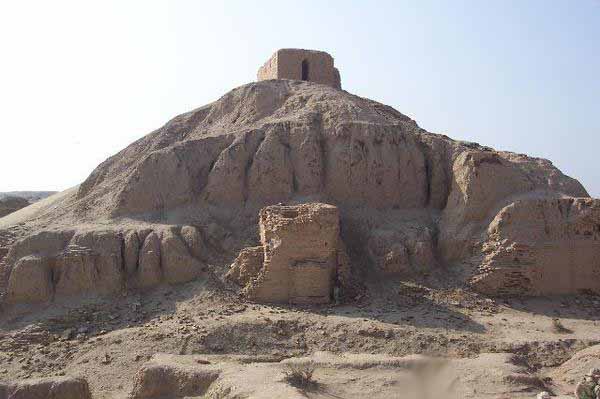
Sumerian Minor Gods and Goddesses
Ereshkigal
It was said that she had been stolen away by Kur and taken to the Underworld, where she was made queen unwillingly. She is actually the twin sister of Enki. Ereshkigal was the only one who could pass judgement and give laws in her kingdom, and her name means "Lady of the Great Place", "Lady of the Great Earth", or "Lady of the Great Below". Her main temples were at Kutha and Sippar.
Ereshkigal was also Inanna and Ishtar (see below).
Inanna - Eanna
Inanna's Knot
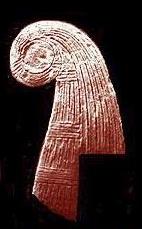 -
- 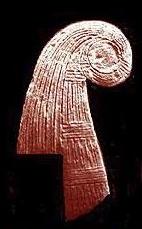
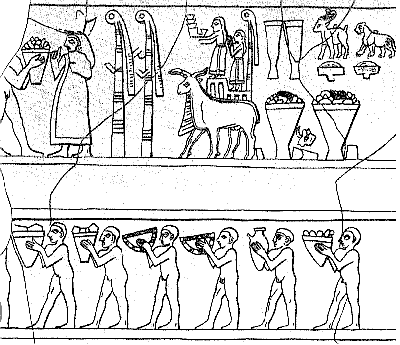
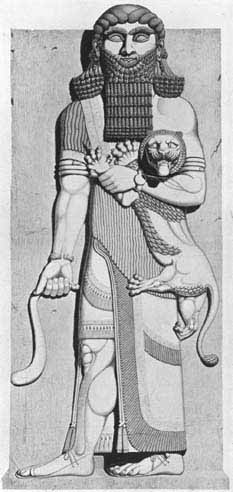 Gilgamesh
Gilgamesh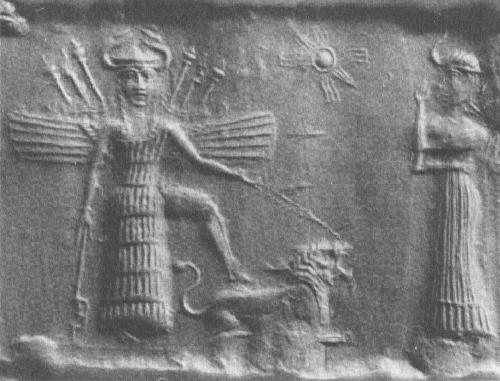
During the time the Goddess Inanna ruled the people of Sumer, they and their communities prospered and thrived. The urban culture, though agriculturally dependent, centered upon the reverence of the Goddess - a cella, or shrine, in her honor was the centerpiece of the cities. Inanna was the queen of seven temples throughout Sumer.
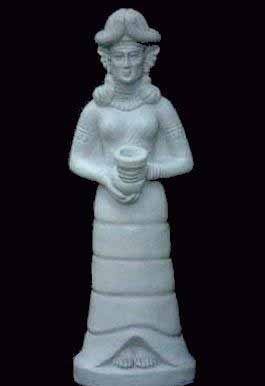
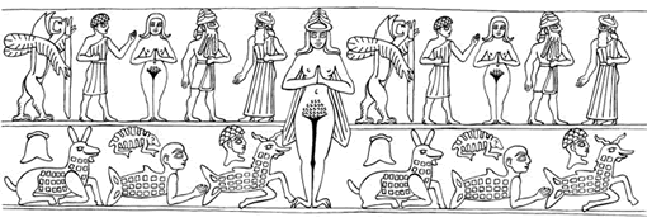
Mesopotamian cylinder seal. Hematite. 2000-1600 BCE.
with spaces for workshops, and was walled off from the city.
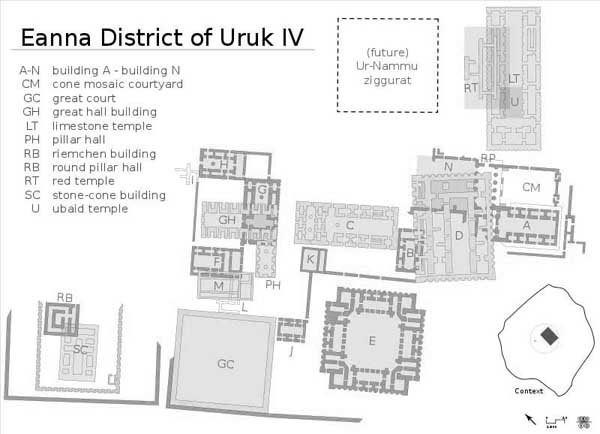
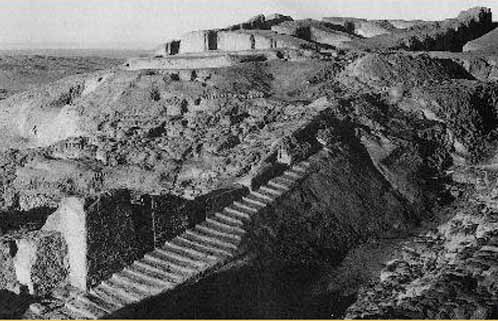 Remains of the Eanna Temple and Ziggurat at Uruk
Remains of the Eanna Temple and Ziggurat at Uruk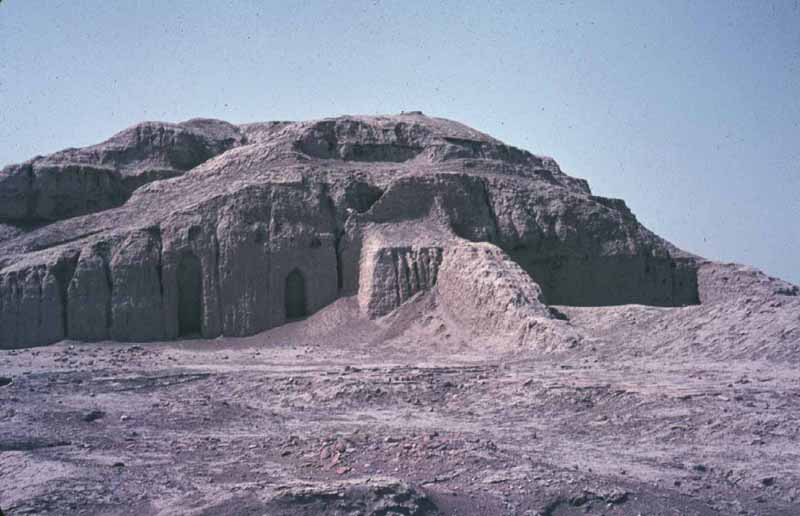
Inanna and Dumuzi
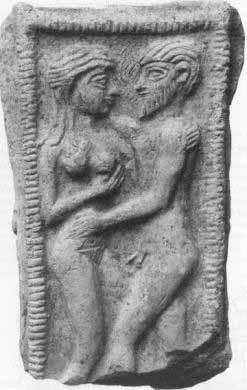
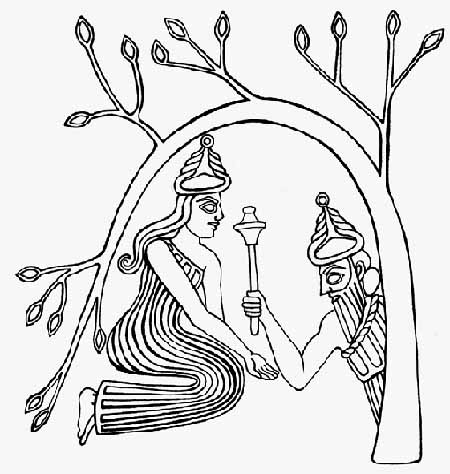
Eanna and Dumuzi create the Tree of Life
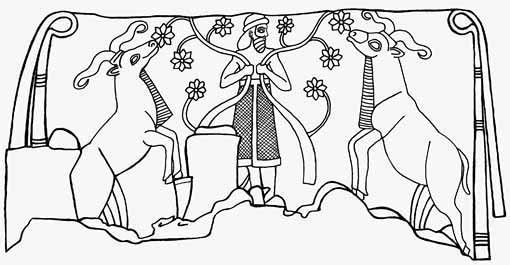 Mesopotamian cylinder seal. Marble. About 3200-3000 BCE.
Mesopotamian cylinder seal. Marble. About 3200-3000 BCE.Dumuzi in net skirt (symbolizes grids) feeding sheep.
Inanna's standards ("gateposts") that frame the image suggest
that the event is happening inside her temple grounds.
Dumuzid or Dumuzi, called "the Shepherd", from Bad-tibira in Sumer, was, according to the Sumerian King List, the fifth predynastic king in the legendary period before the Deluge. The list further states that Dumuzid ruled for 36,000 years.
"Dumuzid the Shepherd" is also the subject of a series of epic poems in Sumerian literature. However, he is described in these tablets as king of Uruk, the title given by the King List to Dumuzid the Fisherman - a distinct figure said to have ruled sometime after the Flood, in between Lugalbanda "the Shepherd" and Gilgamesh.
Among the mythical compositions involving Dumuzid the Shepherd are:
Inanna's descent to the netherworld: Inanna, after descending to the underworld, is allowed to return, but only with an unwanted entourage of demons, who insist on taking away a notable person in her place. She dissuades the demons from taking the rulers of Umma and Bad-tibira, who are sitting in dirt and rags. However, when they come to Uruk, they find Dumuzid the Shepherd sitting in palatial opulence, and seize him immediately, taking him into the underworld as Inanna's substitute.
Dumuzid and Ngeshtin-ana: Inanna gives Dumuzid over to the demons as her substitute; they proceed to violate him, but he escapes to the home of his sister, Ngeshtin-ana (Geshtinanna). The demons pursue Dumuzid there, and eventually find him hiding in the pasture.
Dumuzid and his sister: Fragmentary. Dumuzid's sister seems to be mourning his death in this tablet.
Dumuzid's dream: In this account, Dumuzid dreams of his own death and tells Ngeshtin-ana, who tells him it is a sign that he is about to be toppled in an uprising by evil and hungry men (also described as galla, 'demons') who are coming to Uruk for the king. No sooner does she speak this, than men of Adab, Akshak, Uruk, Ur, and Nibru are indeed sighted coming for him with clubs. Dumuzid resolves to hide in the district of Alali, but they finally catch him. He escapes from them and reaches to the district of Kubiresh, but they catch him again. Escaping again to the house of Old Woman Belili, he is again caught, but then escapes once more to his sister's home. There he is caught a last time, hiding in the pasture, and killed.
Inanna and Bilulu: This describes how Inanna avenges her lover Dumuzid's death, by killing Old Woman Bilulu (or Belili).
In a chart of antediluvian generations in Babylonian and Biblical traditions, William Wolfgang Hallo associates Dumuzid with the composite half-man, half-fish counselor or culture hero (Apkallu) An-Enlilda, and suggests an equivalence between Dumuzid and Enoch in the Sethite Genealogy given in Genesis chapter 5
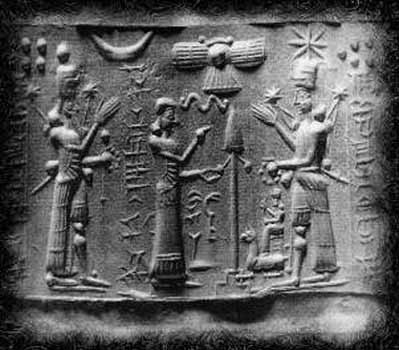
Inanna would play Isis and Ishtar, among others.
Ishtar
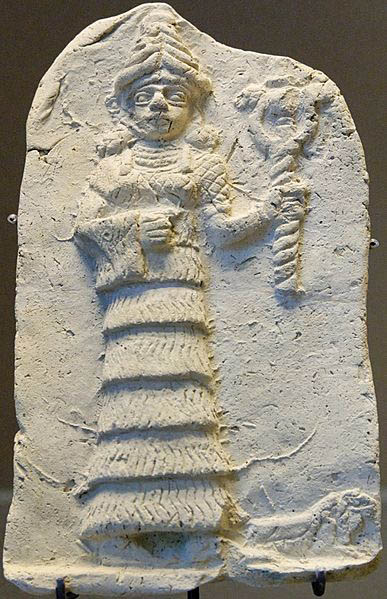
Ishtar Eshnunna Louvre
 British Museum Queen of the Night
British Museum Queen of the NightIshtar is the Akkadian counterpart to the Sumerian Inanna and to the cognate northwest Semitic goddess Astarte. Anunit, Astarte and Atarsamain are alternative names for Ishtar. Inanna, twin of Utu/Shamash, children of Nannar/Sin, first born on Earth of Enlil. The first names given are Sumerian, the second names derive from the Akkadians, who are a Semitic people who immigrated into Sumeria. Adding an [sh] to a name is typical Akkadian, as Anu to Anush.
The goddess represents the planet Venus. (A continent on Venus is named Ishtar Terra by astronomers today.) The double aspect of the goddess may correspond to the difference between Venus as a morning star and as an evening star. In Sumerian the planet is called "MUL.DILI.PAT" meaning "unique star".
The name Inanna (sometimes spelled Inana) means "Great Lady of An", where An is the god of heaven. The meaning of Ishtar is not known, though it is possible that the underlying stem is the same as that of Assur, which would thus make her the "leading one" or "chief". In any event, it is now generally recognized that the name is Semitic in origin.
The Sumerian Inanna was first worshiped at Uruk (Erech in the Bible, Unug in Sumerian) in the earliest period of Mesopotamian history. In incantations, hymns, myths, epics, votive inscriptions, and historical annals, Inanna/Ishtar was celebrated and invoked as the force of life. But there were two aspects to this goddess of life. She was the goddess of fertility and sexuality, and could also destroy the fields and make the earth's creatures infertile. She was invoked as a goddess of war, battles, and the chase, particularly among the warlike Assyrians. Before the battle Ishtar would appear to the Assyrian army, clad in battle array and armed with bow and arrow. (compare Greek Athena.)
One of the most striking Sumerian myths describes Inanna passing through seven gates of hell into the underworld. At each gate some of her clothing and her ornaments are removed until at the last gate she is entirely naked. Ereshkigal, the queen of the underworld kills her and hangs her corpse on a hook on the wall. When Inanna returns from the underworld by intercession of the clever god, her uncle, Enki, according to the rules she must find someone to take her place. On her way home she encounters her friends prostrated with grief at her loss, but in Kulaba, her cult city, she finds her lover Dumuzi, a son of Enki, Tammuz seated in splendour on a throne, so she has him seized and dragged below. Later, missing him, she arranges for his sister to substitute for him during six months of the year.
In all the great centres Inanna and then Ishtar had her temples: E-anna, "house of An", in Uruk; E-makh, "great house", in Babylon; E-mash-mash, "house of offerings", in Nineveh. Inanna was the guardian of prostitutes, and probably had priestess-prostitutes to serve her. She was served by priests as well as by priestesses. The (later) votaries of Ishtar were virgins who, as long as they remained in her service, were not permitted to marry.
Inanna was also associated with beer, and was the patroness of tavern keepers, who were usually female in early Mesopotamia.
Ishtar is also an omnipresent figure in the epic of Gilgamesh. She appears also on the Uruk vase, one of the most famous ancient Mesopotamian artifacts. The relief on this vase seems to show Inanna conferring kingship on a supplicant. Various inscriptions and artifacts indicate that kingship was one of the gifts bestowed by Inanna on the ruler of Uruk.
On monuments and seal-cylinders Inanna/Ishtar appears frequently with bow and arrow, though also simply clad in long robes with a crown on her head and an eight-rayed star as her symbol. Statuettes have been found in large numbers representing her as naked with her arms folded across her breast or holding a child.
Together with the moon god Nanna or Suen (Sin in Akkadian), and the sun god Utu (Shamash in Akkadian), Inanna/Ishtar is the third figure in a triad deifying and personalizing the moon, the sun, and the earth: Moon (wisdom), Sun (justice) and Earth (life force). This triad overlies another: An, heaven; Enlil, earth; and Enki (Ea in Akkadian), the watery deep.
Symbol: an eight or sixteen-pointed star Sacred number: 15 Astrological region: Dibalt(Venus) and the Bowstar (Sirius) Sacred animal: lion, (dragon)
Ishtar Gate
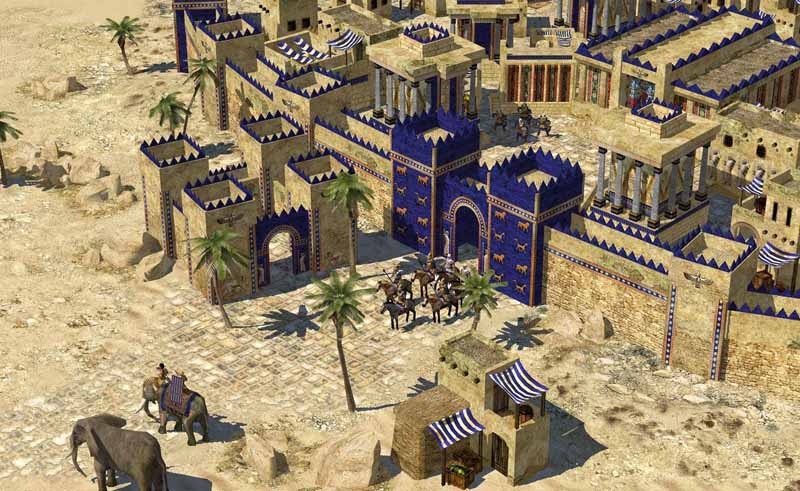
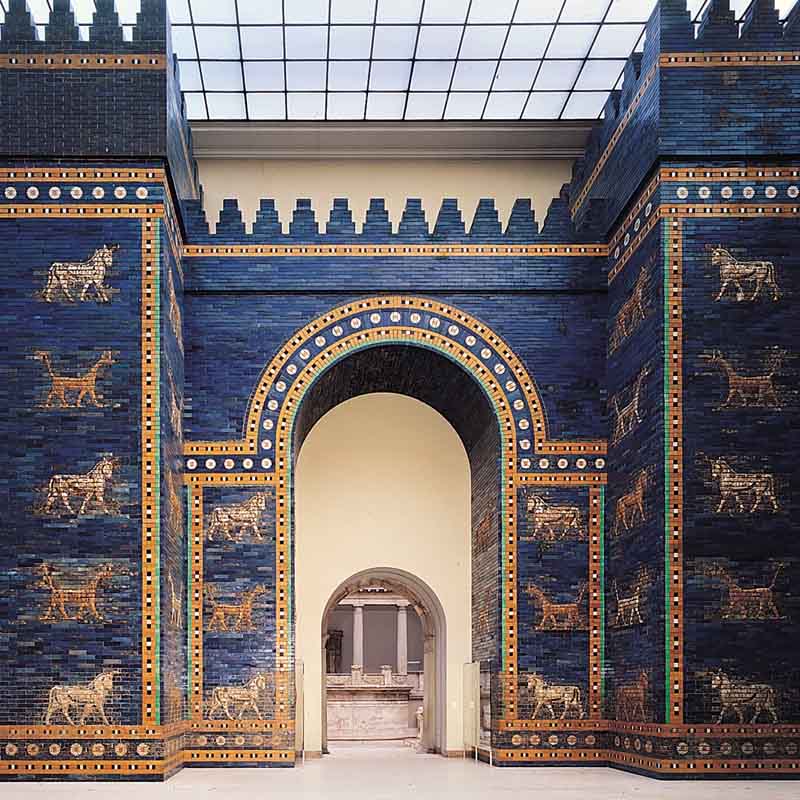
The Ishtar Gate survives today in the Pergamon Museum in Berlin.
Ishtar Gate Ruins
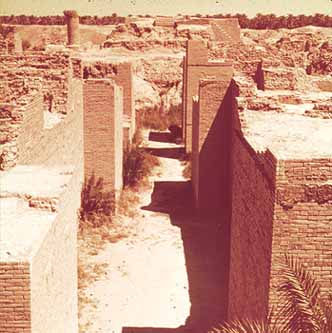
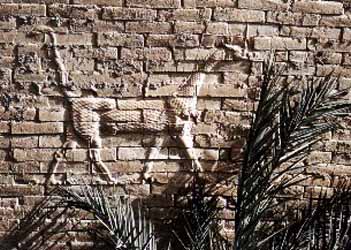
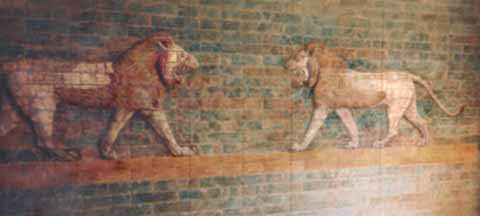
Marduk
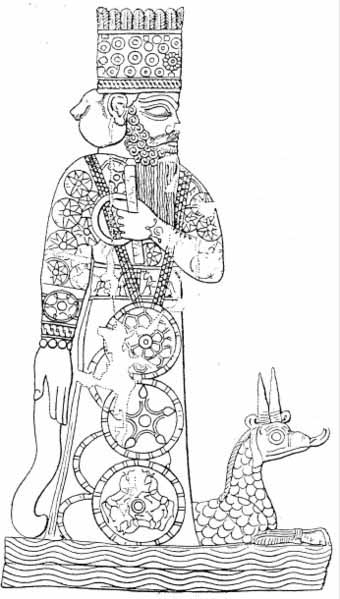
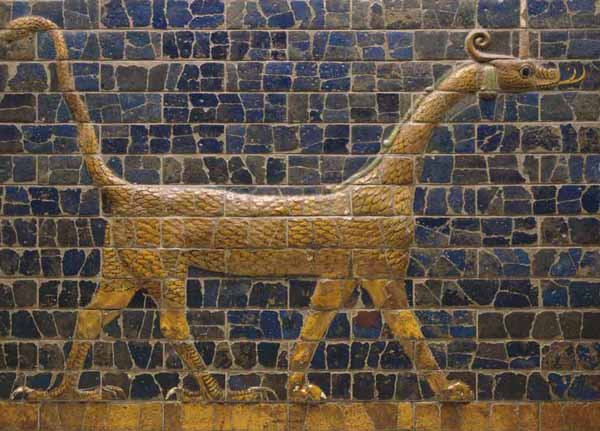 Snake-Dragon, Symbol of Marduk, the Patron God of Babylon.
Snake-Dragon, Symbol of Marduk, the Patron God of Babylon.Panel from the Ishtar Gate, 604-562 BCE, glazed earthenware bricks.
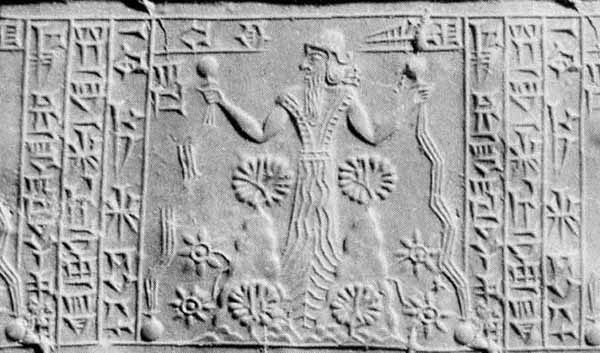
Marduk (Sumerian spelling in Akkadian AMAR.UTU "solar calf"; Biblical Merodach) was the name of a late generation god from ancient Mesopotamia and patron deity of the city of Babylon, who, when Babylon permanently became the political center of the Euphrates valley in the time of Hammurabi (18th century BC), started to slowly rise to the position of the head of the Babylonian pantheon, position he fully acquired by the second half of the second millennium BCE.
Marduk's original character is obscure, but whatever special traits Marduk may have had were overshadowed by the reflex of the political development through which the Euphrates valley passed and which led to imbuing him with traits belonging to gods who at an earlier period were recognized as the heads of the pantheon.
There are more particularly two gods - Ea and Enlil - whose powers and attributes pass over to Marduk. In the case of Ea the transfer proceeds pacifically and without involving the effacement of the older god. Marduk is viewed as the son of Ea. The father voluntarily recognizes the superiority of the son and hands over to him the control of humanity. This association of Marduk and Ea, while indicating primarily the passing of the supremacy once enjoyed by Eridu to Babylon as a religious and political centre, may also reflect an early dependence of Babylon upon Eridu, not necessarily of a political character but, in view of the spread of culture in the Euphrates valley from the south to the north, the recognition of Eridu as the older centre on the part of the younger one.
While the relationship between Ea and Marduk is thus marked by harmony and an amicable abdication on the part of the father in favor of his son, Marduk's absorption of the power and prerogatives of Enlil of Nippur was at the expense of the latter's prestige. After the days of Hammurabi, the cult of Marduk eclipses that of Enlil, and although during the four centuries of Kassite control in Babylonia (c. 1570 BC-1157 BC), Nippur and the cult of Enlil enjoyed a period of renaissance, when the reaction ensued it marked the definite and permanent triumph of Marduk over Enlil until the end of the Babylonian empire. The only serious rival to Marduk after ca. 1000 BC is Anshar in Assyria. In the south Marduk reigns supreme. He is normally referred to as Bel "Lord".
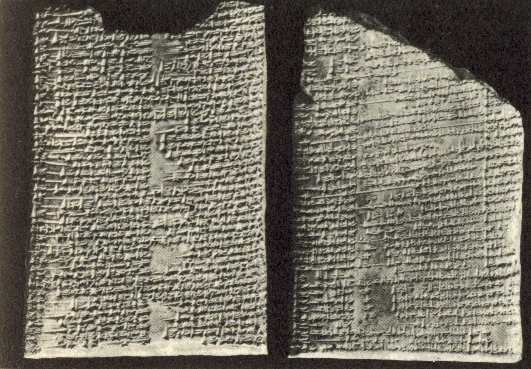 Enuma Elish
Enuma ElishIn Enuma Elish a civil war between the gods was growing to a climatic battle. The Anunnaki gods gathered together to find one god who could defeat the gods rising against them. Marduk, a very young god, answered the call, and was promised the position of head god.When he killed his enemy he "wrested from him the Tablets of Destiny, wrongfully his" and assumed his new position. Under his reign humans were created to bear the burdens of life so the gods could be at leisure.
People were named after Marduk. For example, the Biblical personality Mordechai (Book of Esther) used this Gentile name in replacement of his Hebrew name Bilshan.Ba bylonian texts talk of the creation of Eridu by the god Marduk as the first city, 'the holy city, the dwelling of their the other gods delight'.
Nabu, god of wisdom, is a son of Marduk.
Etemenanki, "The temple of the creation of heaven and earth", was the name of a ziggurat to Marduk in the city of Babylon of the 6th century BC Chaldean (Neo-Babylonian) dynasty. Originally seven stories in height, little remains of it now save ruins. Etemenanki was later popularly identified with the Tower of Babel.
Nammu

Goddess Nammu
In Sumerian mythology, Nammu (more properly Namma) was a primeval goddess, corresponding to Tiamat in Babylonian mythology. Taimat was a primordial goddess who rose from the void and created the collective unconsciousness.
Nammu was the primeval sea (Engur) that gave birth to An (heaven) and Ki (earth) and the first gods, representing the Apsu, the fresh water ocean that the Sumerians believed lay beneath the earth, the source of life-giving water and fertility in a country with almost no rainfall.
Nammu is not well attested in Sumerian mythology. She may have been of greater importance prehistorically, before Enki took over most of her functions. An indication of her continued relevance may be found in the theophoric name of Ur-Nammu, the founder of the Third Dynasty of Ur. According to the Neo-Sumerian mythological text Enki and Ninmah, Enki is the son of An and Nammu. Nammu is the goddess who "has given birth to the great gods". It is she who has the idea of creating mankind, and she goes to wake up Enki, who is asleep in the Apsu, so that he may set the process going.
King Ur-Nammo - Third King of Ur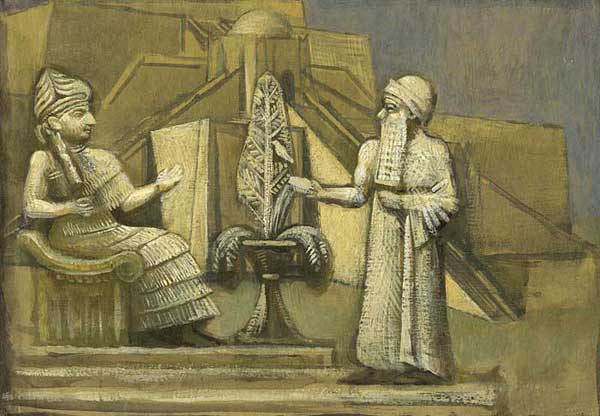
Nammu and the Tree of Life at Ur
 Steal of Ur-Nammu at Ur
Steal of Ur-Nammu at UrNergal
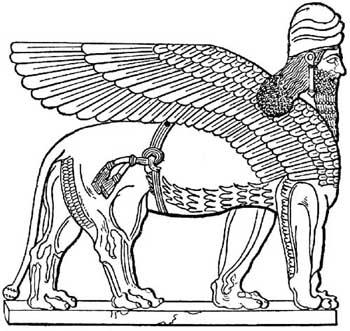
Nergal refers to a deity in Babylon with the main seat of his cult at Cuthah represented by the mound of Tell-Ibrahim. Nergal is mentioned in the Hebrew bible as the deity of the city of Cuth (Cuthah): "And the men of Babylon made Succoth-benoth, and the men of Cuth made Nergal" (2 Kings, 17:30). According to the rabbins, his emblem was a cock and Nergal means a "dunghill cock". He is the son of Enlil and Ninlil.
Nergal actually seems to be in part a solar deity, sometimes identified with Shamash, but a representative of a certain phase only of the sun. Portrayed in hymns and myths as a god of war and pestilence, Nergal seems to represent the sun of noontime and of the summer solstice which brings destruction to mankind, high summer being the dead season in the Mesopotamian annual cycle.
Nergal was also the deity who presides over the nether-world, and who stands at the head of the special pantheon assigned to the government of the dead (supposed to be gathered in a large subterranean cave known as Aralu or Irkalla). In this capacity he has associated with him a goddess Allatu or Ereshkigal, though at one time Allatu may have functioned as the sole mistress of Aralu, ruling in her own person. In some texts the god Ninazu is the son of Nergal by Allatu/Ereshkigal.
Ordinarily Nergal pairs with his consort Laz. Standard iconography pictured Nergal as a lion, and boundary-stone monuments symbolise him with a mace surmounted by the head of a lion.
Nergal's fiery aspect appears in names or epithets such as Lugalgira, Sharrapu ("the burner," perhaps a mere epithet), Erra, Gibil (though this name more properly belongs to Nusku), and Sibitti. A certain confusion exists in cuneiform literature between Ninurta and Nergal. Nergal has epithets such as the "raging king," the "furious one," and the like. A play upon his name separated into three elements as Ne-uru-gal (lord of the great dwelling) expresses his position at the head of the nether-world pantheon.
In the astral-theological system Nergal becomes the planet Mars, while in ecclesiastical art the great lion-headed colossi serving as guardians to the temples and palaces seem to symbolise Nergal, just as the bull-headed colossi probably typify Ninurta.
Nergal's chief temple at Cuthah bore the name Meslam, from which the god receives the designation of Meslamtaeda or Meslamtaea, "the one that rises up from Meslam". The name Meslamtaeda/Meslamtaea indeed is found as early as the list of gods from Fara while the name Nergal only begins to appear in the Akkadian period.
The cult of Nergal does not appear to have spread as widely as that of Ninurta. Hymns and votive and other inscriptions of Babylonian and Assyrian rulers frequently invoke him, but we do not learn of many temples to him outside of Cuthah. Sennacherib speaks of one at Tarbisu to the north of Nineveh, but significantly, although Nebuchadnezzar II (606 BC 586 BC), the great temple-builder of the neo-Babylonian monarchy, alludes to his operations at Meslam in Cuthah, he makes no mention of a sanctuary to Nergal in Babylon. Local associations with his original seat Kutha and the conception formed of him as a god of the dead acted in making him feared rather than actively worshipped.
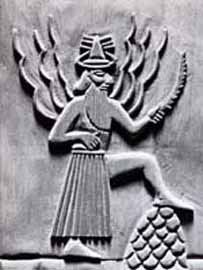
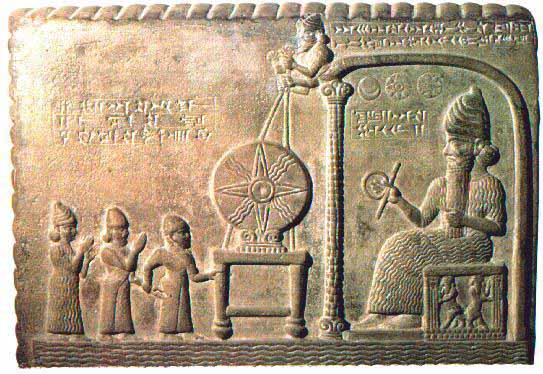
The name signifies perhaps "servitor," and would thus point to a secondary position occupied at one time by this deity. Both in early and in late inscriptions Sha-mash is designated as the "offspring of Nannar," i.e. of the moon-god, and since, in an enumeration of the pantheon, Sin generally takes precedence of Shamash, it is in relationship, presumably, to the moon-god that the sun-god appears as the dependent power.
Such a supposition would accord with the prominence acquired by the moon in the calendar and in astrological calculations, as well as with the fact that the moon-cult belongs to the nomadic and therefore earlier, stage of civilization, whereas the sun-god rises to full importance only after the agricultural stage has been reached.
The two chief centres of sun-worship in Babylonia were Sippar, represented by the mounds at Abu Habba, and Larsa, represented by the modern Senkerah. At both places the chief sanctuary bore the name E-barra (or E-babbara) "the shining house" a direct allusion to the brilliancy of the sun-god. Of the two temples, that at Sippara was the more famous, but temples to Shamash were erected in all large centres such as Babylon, Ur, Mari, Nippur and Nineveh.
The attribute most commonly associated with Shamash is justice. Just as the sun disperses darkness, so Shamash brings wrong and injustice to light. Hammurabi attributes to Shamash the inspiration that led him to gather the existing laws and legal procedures into a code, and in the design accompanying the code the king represents himself in an attitude of adoration before Shamash as the embodiment of the idea of justice.
Several centuries before Hammurabi, Ur-Engur of the Ur dynasty (c. 2600 BC) declared that he rendered decisions "according to the just laws of Shamash."
It was a logical consequence of this conception of the sun-god that he was regarded also as the one who released the sufferer from the grasp of the demons. The sick man, therefore, appeals to Shamash as the god who can be depended upon to help those who are suffering unjustly. This aspect of the sun-god is vividly brought out in the hymns addressed to him, which are, therefore, among the finest productions in the entire realm of Babylonian literature.
It is evident from the material at our disposal that the Shamash cults at Sippar and Larsa so overshadowed local sun-deities elsewhere as to lead to an absorption of the minor deities by the predominating one. In the systematized pantheon these minor sun-gods become attendants that do his service. Such are Bunene, spoken of as his chariot driver, whose consort is Atgi-makh, Kettu ("justice") and Mesharu ("right"), who are introduced as servitors of Shamash.
Other sun-deities, as Ninurta and Nergal, the patron deities of important centres, retained their independent existence as certain phases of the sun, Ninib becoming the sun-god of the morning and of the spring time, and Nergal the sun-god of the noon and of the summer solstice, while Shamash was viewed as the sun-god in general.
Together with Sin and Ishtar, Shamash forms a second triad by the side of Anu, Enlil and Ea. The three powers, Sin, Shamash and Ishtar, symbolized the three great forces of nature, the sun, the moon and the life-giving force of the earth.
At times, instead of Ishtar, we find Adad, the storm-god, associated with Sin and Shamash, and it may be that these two sets of triads represent the doctrines of two different schools of theological thought in Babylonia which were subsequently harmonized by the recognition of a group consisting of all four deities.
The consort of Shamash was known as A. She, however, is rarely mentioned in the inscriptions except in combination with Shamash.
Sin
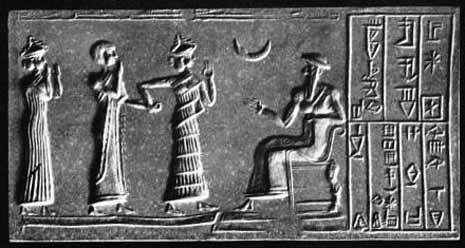

He is commonly designated as En-zu, which means "lord of wisdom". During the period (c.2600-2400 BCE) that Ur exercised a large measure of supremacy over the Euphrates valley, Sin was naturally regarded as the head of the pantheon. It is to this period that we must trace such designations of Sin as "father of the gods", "chief of the gods", "creator of all things", and the like. The "wisdom" personified by the moon-god is likewise an expression of the science of astronomy or the practice of astrology, in which the observation of the moon's phases is an important factor.
His wife was Ningal ("Great Lady"), who bore him Utu/Shamash ("Sun") and Inanna/Ishtar (the goddess of the planet Venus). The tendency to centralize the powers of the universe leads to the establishment of the doctrine of a triad consisting of Sin/Nanna and his children.
Sin had a beard made of lapis lazuli and rode on a winged bull. The bull was one of his symbols, through his father, Enlil, "Bull of Heaven", along with the crescent and the tripod (which may be a lamp-stand). On cylinder seals, he is represented as an old man with a flowing beard and the crescent symbol. In the astral-theological system he is represented by the number 30 and the moon. This number probably refers to the average number of days (correctly around 29.53) in a lunar month, as measured between successive new moons.
An important Sumerian text ("Enlil and Ninlil") tells of the descent of Enlil and Ninlil, pregnant with Nanna/Suen, into the underworld. There, three "substitutions" are given to allow the ascent of Nanna/Suen. The story shows some similarities to the text known as "The Descent of Inanna".
Nanna's chief sanctuary at Ur was named E-gish-shir-gal ("house of the great light"). It was at Ur that the role of the En Priestess developed. This was an extremely powerful role held by a princess, most notably Enheduanna, daughter of King Sargon of Akkad, and was the primary cult role associated with the cult of Nanna/Sin. Sin also had a sanctuary at Harran, named E-khul-khul ("house of joys"). The cult of the moon-god spread to other centers, so that temples to him are found in all the large cities of Babylonia and Assyria. A sanctuary for Sin with Syriac inscriptions invoking his name dating to the 2nd and 3rd centuries CE was found at Sumatar Harabesi in the Tektek mountains, not far from Harran and Edessa.
Sumerian Demi-Gods
Enkidu
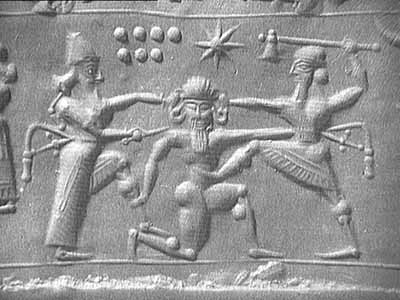
Gilgamesh mourns over the body of Enkidu for several desperate days. In a vivid line repeated in the epic, Gilgamesh only allows his friend to be buried after a maggot falls out of the corpse's nose. Gilgamesh's close observation of rigor mortis and the slow decomposition of Enkidu's body provides the hero with the impetus for his quest for eternal life, and his visit to Utnapishtim.
There is another non-canonical tablet in which Enkidu journeys into the underworld, but many scholars consider the tablet to be a sequel or add-on to the original epic.
In Sumerian mythology:
- She is the daughter of Enki and Ninhursag.When Dumuzi died, Geshtinanna lamentated days and nights.
After her death, she became the goddess of wine and cold seasons. She is a divine poet and interpreter of dreams.
It was to share the sorrow with her sister that Inanna later descends to the Underworld.
Taurus was the constellation of the Northern Hemisphere Spring Equinox from about 3,200 BCE. It marked the start of the agricultural year with the New Year Akitu festival an important date in Mespotamian religion. The "death" of Gugalanna, represents the obscuring disappearance of this constellation as a result of the light of the sun, with whom Gilgamesh was identified.
In the time in which this myth was composed, the New Year Festival, or Akitu, at the Spring Equinox, due to the Precession of the Equinoxes did not occur in Aries, but in Taurus. At this time of the year, Taurus would have disappeared as it was obscured by the sun.
THE ANUNNAKI
By Estelle Nora Harwit Amrani, with Enki's Assistance
in the beginning.....
When the Source (G-d) created souls in order to be able to reflect back to itself what it was, beings later manifested in the constellation of Lyra. These were the first "creator gods" (the Council of Twelve and Elohim) who knew how to create matter from light. And create they did - planets, stars, universes, life forms for themselves, and eventually others. The Lyran's physical lifetimes lasted for approximately one thousand years. In time, however, their life span decreased. They sought out something that would enable them to live longer lives so that they could experience the wonder and miracle of existence. They found that gold not only increased their longevity, but provided them with a superconductivity which gave them the ability to be very telepathic and experience their multidimensionality. Many thousands of years passed, and the beings from Lyra spread out into the cosmos and created new civilizations. Some went to Vega, others the Pleiades, and yet others Sirius. But, they knew (more or less) of their roots in Lyra/Vega and Sirius and that they were creator gods, at that point a.k.a. the Watchers. The search for gold to maintain their longevity continued because, unfortunately, their source for this magical substance was not forever lasting. Their planet (part of Sirius) was destroyed and their lives were doomed. They had to find another way of living - elsewhere.
The following universal history information is from Bashar (channeled by Darryl Anka), and Enki [through myself]: "Approximately 4.6 billion years ago in our solar system there existed: Mercury, Venus, Mars (no moons), a 4th planet (larger than Earth with many moons, including a large one), Jupiter, Saturn (no rings), Uranus, Neptune and Pluto (which was a satellite of Saturn).
"4 billion years ago, another planet came into our still forming solar system. This planet had its own moons. It arrived at approximately the same orbit as the 4th planet called Maldek - the one that existed beyond Mars. Mars was then the 3rd planet. [Please read the Sumerian Epic of Creation - the Enuma Elish, as this says it all and explains the importance of the Tablets of Destiny.] "This planet's moons impacted the 4th planet shattering it so that part of it became the Asteroid Belt. The remnant of the impact (as it cooled and moved into a tighter orbit around the sun) became the Earth and brought with it the large planet that was the moon of the 4th planet. This is our moon. Approx. 67% of the former planet is Earth. Earth brought with it water - but there was water on the other planet, as well. As it reformed and became a sphere again, the rift where the shattering took place is now the Pacific Ocean area.
"This other planet was responsible for shattering the moons gravitationally that caused Saturn's rings and for turning Uranus on its side, so that it has a highly inclined axis. And - this also caused Pluto to release from Saturn and come into its own orbit."
This planet, of course, that caused all the havoc was/is Nibiru. It is our 10th planet - not really the 12th. In the late 1980's it was about halfway back. *Please see an important update from August 3, 2011 at bottom of this page. Bases were set up on the Moon. Mars' moons - Phobos and Deimos, are remnants of that original impact that created the Asteroid Belt. These moons have been used for bases and minerals and water. [The above information on the solar system is recorded in ancient texts, and has been accessed through memory and channelings by myself, in sessions by Bashar, and other entities.] End of the "in the beginning part." [Important and interesting update, November 13, 2007: "It may not be likely," NASA researcher David Morrison told National Geographic News, "but we cannot exclude the possibility that we are, in effect, all Martians." A European experiment last month demonstrates that microscopic life could indeed survive inside rocks hurtling through space. Read the story at National Geographic News] Next phase: The group of beings who originated in Lyra later split up and evolved into Vegans, Sirians and Pleiadeans, are known as the Anunnaki. This particular group is attributed to having their own satellite. Their "planet" (which is partially artificial) was considered to be Nibiru. However, Nibiru is not really the home of the Anunnaki. Nibiru was made up of what I'd call space pirates who imitated other beings, and sometimes a few from one planet would join them, including the Anunnaki. I've seen these pirates - they're not like the real Anunnaki. The story of the Anunnaki has been mixed up with these pirates through time so some see the Anunnaki as being only evil. (Some of the Anunnaki also were present on Mars before it was destroyed, and here's an article that talks about Mars.)
The name "Anunnaki" can mean many different things [based on Hebrew interpretations] - it is rich with meaning. "An" is short for "anachnu," which means "we." "An" also means "heaven." "Naki" means "clean." So, the name can mean "We are clean" and "heaven is clean," clean as in "pure." "Ki" means "Earth," so "We are here on Earth." "Heaven is on Earth." "Anu is here on Earth." The "we" is also meant as a collective oneness, of the Source.
They were tall, giant, (in Hebrew the word for giants is "Anakim") and have also been called the Nordics or Blonds, even though not all of them had blond hair or blue eyes. It is easy to see their Lyran and Sirian roots in their appearance. They also glowed a golden color. Their symbol is the winged disk, which not only represents their starships, but also symbolic of the ability of the spirit to fly free while remembering it's wise, divine source. These Anunnaki were later called the Elohim, and Nephilim (those who descended, came down). However, they were NOT "the" Elohim, but Elohim became the word used for the plural of god. They were extraterrestrials. In B'raisheet (Genesis) 6:4 it is written: "The Lord said, "My breath shall not abide in man forever, since he too is flesh; let the days be allowed him be one hundred and twenty years." It was then, and later too, that the Nephilim appeared on earth - when the divine beings cohabited with the daughters of men, who bore them offspring. They were the heroes of old, men of renown." It is thought, by some, that the Nephilim were sinful gods who "fell from grace." They fell, alright, in their spaceships. This can also be seen as symbolic. The "fall" having to do with lowering one's frequency from spirit into physical matter, which is slower and denser. "Fall" also meaning forgetting one's true Source. As life forms choose to come to Earth their vibration goes through changes so that they are more matched to the frequency of Earth, their new home. Now these ETs literally came down from space, but souls choosing to incarnate upon the earth also had to change their vibrational frequencies. Enlil was first to come to Earth and was there even before mankind was created. The Sumerian texts called mankind the "Black-Headed People." If anyone doubts the location of Eden, or why it was chosen by the Anunnaki as a locale, please read on from Genesis:
"Then, before there was any rain, he formed man, from the dust of the earth. He blew into his nostrils the breath of life, and man became a living being. The Lord God planted a garden in Eden, in the east, and placed there the man whom He had formed..." and then all the other life forms came into being, water, animals, minerals. Genesis does say that the first river in Eden was Pishon and winds through the whole land of Havilah, where the gold is - the gold of that land is good; bdellium is there, and lapis lazuli. The name of the second river is Gihon, the one that winds through the whole land of Cush. The name of the third river is Tigris, the one that flows east of Asshur. And the fourth river is the Euphrates.
[For more Biblical references to the Anakim, Anakites, Anunnaki, Nephilim, etc., please see: Numbers: 13:22; 13:28-33; Deut: 1:28; 2:1-; 9:2; Joshua: 11:21-22; 14:12; 14:15; 15:13-14; Judges: 1:20. Many of these giants were the result of Anunnaki and human reproduction, such as Gilgamesh.] Being a dreamtime medicine person, I traveled to this place of human's origins and saw the space pirates who gave the impression of being the Anunnaki. This was on the border of Iran and Iraq at Lake Zaga. This lake no longer exists, as it has been covered up by sand, but it exists inside the earth and interdimensionally. To date no one else has ever talked about Lake Zaga or knows where it is - that is, aside from myself and channeled entities who have confirmed my visions and memories of it. I would like to find someone who can provide me with archaeological, geological evidence that this place once existed. I also know the language of the place, and how there are underground facilities, passageways, there. It was once controlled by renegade Anunnaki pirates. There are many interesting details of how this place once looked, but I am preserving this information for another time.
This is part of Earth's story and occurred after there already was life on Earth, homonid beings. Hominids are distinctly human-like creatures, different from apes or chimpanzees. The Anunnaki came to Earth (some of their crafts had crashed in the process), for a haven for themselves, and found it rich with gold, copper, silver and other minerals. They felt that here was their last chance for longevity, survival and the gold was the best conductor of energy which had many important uses. They mined gold for a very long time - hundreds of thousands of years by our standards; for theirs only a few weeks have passed.
What, according to the Old Testament happened? God said, "Now that the man has become like one of us, knowing good and bad, what if he should stretch out his hand and take also from the tree of life and eat, and live forever!" So man was banished from Eden to work the soil from which he was taken.
Further on in Genesis, we read:
"The Lord saw how great was man's wickedness on earth, and how every plan devised by his mind was nothing but evil all the time. And the Lord regretted that He had made man on earth, and His heart was saddened. The Lord said, "I will blot out from the earth the men whom I created - men together with beasts, creeping things, and birds of the sky; for I regret that I made them." But Noah found favor with the Lord....For My part, I am about to bring the Flood - waters upon the earth - to destroy all flesh under the sky in which there is breath of life; everything on earth shall perish. But I will establish My covenant with you, and you shall enter the ark, with your sons..."" This ark was symbolic and literal, not only a ship, but a covenant. [An aside: a thought: when it says in the bible that God told Noah to build the ark out of gopher wood, maybe it was a mistranslation. God could have just been commanding Noah to go for wood - like go for camel, go for bread, go for nameless wife...] Stephanie Dalley, author and translator, states from her book "Myths From Mesopotamia: Creation, The Flood, Gilgamesh and Others (1991) that in the "Epic of Creation" (the epic which explains the history of the cosmos, and the Anunnaki as creator gods), the key element involves the possession of the Tablets of Destinies (which I will discuss at a later time because it's very relevant to today). There also could have been several different versions spread around retelling the Epic. About the Epic, Ms. Dally writes: "Here is no struggle against fate, no mortal heroes, no sense of suspense over the outcome of events. The success of the hero-god Marduk is a foregone conclusion. None of the good gods is injured or killed; no tears are shed. Yet cosmic events are narrated: the earliest generations of the gods are recounted leading up to the birth of the latest hero-god; the forces of evil and chaos are overcome, whereupon the present order of the universe can be established, with its religious centres, its divisions of time, its celestial bodies moving according to proper rules, and with mankind invented to serve the does. The gods themselves behave in an orderly fashion: they assemble, discuss, agree, and elect their leaders in a gathering of males; after Tiamat's primeval parturition and the spawning of monsters, goddesses play no part in creating the civilized world, not even in creating mankind." [p. 228]
However, I find this hard to believe because without a female donor, beings could not procreate, not give birth, and so on. There have been many women I have personally met who remember being birth goddesses, used by the aliens to have embryos implanted within them, to go through the pregnancies and give birth, then raise the children - if they survived. Dalley also writes that in the Atrahasis, the mother goddess, Ninhursag/Ninharsag-Ki, (Mami, Nintu, who I abbreviate as "Nin"), with Ea, make man out of clay, mixed with the blood from a god slain by Nin, Geshtu-e: "A ghost came into existence from the god's flesh, And she (Nin) proclaimed it as his living sign. The ghost existed so as not to forget (the slain god)." Mixing and concocting continues and the "womb-goddesses" (creator of fate) were assembled. When birthing time arrived, Nin served as the mid-wife. The ghost is the spirit, the breath, divine life force, that was NOT created by the Anunnaki. This is only created by The Source. [Personal note: My spelling of Ninhursag is how the name is spoken, and how it is in my memory. When analyzed numerologically, it has a number of 111, which according to Norma Smith, Expert Analyst and Ph.D. in Universal Harmonics Analysis, is a master triple number, and its meaning is DNA template for humanity. I think Sitchen's spelling of the name as Ninharsag is to justify his translation of the name through Hebrew - "har" meaning "mountain." Ninharsag has a value of 91 and means "spirit" and "oneness." So, it is more of a spiritual name for Ninhursag.]
In Dalley's own translation of the Epic, Tiamat is a female who is plotted against by her own family, and then has the tables turned on her by her lover Kingu (Qingu, or Zu) and the Anunnaki, after she gives him the Tablets of Destiny - the Anu power. Ea, married to Damkina, overhears the plot and takes the fate into his own hands, slaying Apsu and Mummu. Afterwards he rested in his own quarters and named them Apsu and made his home there. Here is where he and Damkina created their son Marduk, and Marduk was raised by a nurse and he was suckled by the goddesses. What follows in the Epic is a war (created by accusations and conspiracies back and forth) between the forces of Anshar, his son Anu, his son EA, and his son Marduk against Tiamat and Kingu. Marduk slays Tiamat - of womankind - the gods rejoice and make Marduk their leader. Marduk took back the Tablets of Destinies and became the king of the entire universe. Let's remember that we're talking about extraterrestrials here, (symbolic and literal); not THE Source.   The grand spirit, Dr. Peebles, who speaks through many channelers (including myself through writing), was channeled in 1989 through Thomas Jacobson. (I attended that public session and transcribed it.) Dr. Peebles talked about these beings coming to Earth and their plan to find a new home for sanctuary, safety and security, and to experiment with consciousness and freedom. They feared procreation and freedom, because in their minds that promised chaos. Yet, they attempted this but their need to control overpowered it. It didn't work and they did condemn themselves for it. They created some of their own karma through their actions. The Anunnaki (who some call the Nephilim) later procreated with the beings who were on Earth at that time. The souls of those who became human came to Earth by their own free will to experience physicality. Several other extraterrestrial civilizations later contributed their own input into human DNA and created many races of humans and other creatures (a couple of which have since left this planet - such as the dinosaurs). However, these hybrids (our missing link in our evolution) helped the Anunnaki mine their gold. As seems pretty obvious thus far, the Anunnaki were pattern-makers, the creators of archetypes and a part of the template for human life on Earth. Throughout all cultures on Earth the same story of these gods (albeit with different names depending on where you are), their gifts to humanity, their failures, their characteristics, their loves, their battles and the results of such warfare are recorded in literature, ritual, art, oral tradition and religion. Astrology is one of the major sciences they brought to Earth, and each main god/goddess had their own constellation. The Anunnaki gave the humans knowledge of how to be this human being, how to take care of themselves, gave them guidelines, rules, for proper living. And yet, at times they were also manipulators, and as long as people didn't upset the "gods" they were safe and provided for. After some time, the humans evolved to a point where they began to question their purpose and their future. They rebelled against their "creators," the Anunnaki. The humans wanted to have the nectar of the gods for themselves. Why shouldn't they be able to have their free will, live as long as their gods did? Why shouldn't they have power and wealth or whatever they felt they lacked? And then the sad realization that they were NOT like "the gods." Read the early sad epics of Enkidu and Gilgamesh who desperately wanted to be divine and have everlasting life, only to find out that their mortal side won out. You will also find out more about the flood and the Anunnaki from the Epic of Gilgamesh.  One of the Anunnaki leaders who had no patience for humans was EN.LIL. Enlil was the Prince of heaven and Earth. He was in charge of airspace, he was chief of the gods and Lord of Sumer. Enki and Enlil were half brothers through the same father, Anu, who was the leader of this Anunnaki group. I have a theory that Enki could have been the father of Judaism. Enki and Enlil also had to contend with Marduk (one of Enki's sons) who was proclaimed the greatest king of the gods. In later years, the symbol of the crescent moon was associated with Nanna/Sin (Enlil's and Ninlil's son), who Sinai was named for, and who became known as Allah. Note the symbol (with the star) is used in Islam and is directly related to Enlil's side of the family. This is proof of the battle for power by the two camps of Anunnaki, those of Enki versus those of Enlil - actually a terrible, nuclear war between the Anunnaki took place in the Sinai, and at the Great Pyramid, for control over the region. Ninhursag acted as mediator and brought the two sides to a peace agreement. (But, in fact, there were many more camps that evolved out of Enki and Enlil's lineages.)  Civilizations and religions were created by Enki and Enlil (and later their offspring). Egypt, for example, was developed by Enki and his lineage. The areas of the Sinai, Jerusalem, Sumer, India and more were fought over by the two families of Enki and Enlil, changing hands back and forth through different pyramid wars. (This was the of battles of Ra/Marduk, Horus, Thoth, Inanna, Set, Osiris, and mediated into peace by Nin.] The battle Horus fought for Ra against Seth was the first that used humans in a war with weapons, and this began wars mankind fought against itself. The war between the factions of the Anunnaki continued between humans with claims such as, "There is only One god," or "There are many gods," or "My god is THE god, but yours isn't," or "We are the chosen people, or the superior race - God told us so!" This wasn't from The G-d, the love-energy source of all life: instead this was more reflective of "the creator gods" who had their own beliefs, agendas. The battle between Egypt and Israel goes way back, and it was due to the control and confusion set into motion by many of these factors; extraterrestrials, angels (and messages from THE G-d), humans, mixed messages, control and fear, between worshipping Enki's family or Enlil's family. By the way, I believe that an ancient Anunnaki landing port is located right where the real Mt. Sinai is in the Sinai Peninsula. Atlantis' finally sinking was due to astronomical events combined with those humans and Anunnakis experimenting with sound technology. They didn't plan on destroying the place - they just miscalculated. The last great flood, approximately 13,000 years ago, became a legend when Enki went against the other Anunnaki and saved humans (the Noahs of Earth) when this accident occurred. The first flood was in Lemuria and then there were others in Atlantis (several times). Those with Enki forced Enlil to help save whatever humans they could. Enki, having felt completely disgusted and disappointed by Enlil's fierce control, (refere to the Tower of Babel here) left Earth during the Exodus. Moses in confusion as to who he was speaking with on the mountain. He heard The G-d, messengers (Elohim and Nephilim) as a mixture. The Ten Commandments were supposedly dictated to Moses and he wrote it down, after he was taught the Hebrew alphabet and language, which he would later teach to his people. Have you ever noticed how, at this point in the Hebrew Bible, Adonai is no longer mentioned, and YHWH, Jehovah, Yahweh, is? And yet, everyone thinks they're the same G-d. Just who is this Jehovah, YHWH? Jehovah was an agent of Enlil! Not long after the Exodus, the other Anunnaki left their Earthly influence, and their secrets of transforming gold into the powerful substance that allowed their longevity and spiritual abilities also vanished. Their knowledge about life was held in the hands of very few who began to abuse it and became greedy. Then, in time, humans who remembered died or disappeared. A lot of knowledge was lost. And yet, people kept trying to capture that special essence of gold in the form of statues or other such items, mistakenly believing that power equated to violence and destruction and hoarding wealth. They felt it was their key to immortality - that which would make them THE G-d. Powdered gold has beneficial properties, but the real gold is within - remembering one's self and connection to Source. This is really what Enki had tried to infuse into people. The Anunnaki left the Earth, in a sense, but not without creating counterparts or aspects of themselves who would reincarnate as humans in order to share the human experience with them, their oversouls. Some of these continued the lineage through King David and Jesus. Some of these counterparts or aspects have stubbornly stuck to what they presume was Enlil's and Marduk's agenda to control the Earth for their own purposes, keeping humans more fearful, dependent, ignorant. Yet, others continue to share the ancient wisdom from other Anunnaki, encouraging humanity to remember their source which they can access from within their individual and collective cellular/spiritual memories in order to break the ancient and false bonds of slavery, fear and ignorance and reclaim what they feel is rightfully theirs. Any way you look at it, the confusing, chaotic battle continues - and it doesn't have to. Are these Anunnaki "gods" returning to Earth via Nibiru? (Remember - Nibiru really wasn't the home of the Anunnaki.) "They" have never really left! First of all, they exist in many of us as a reincarnation or as aspects of them. (And boy, that's created some sad, major identity crises.) And as a human civilization, we have finally reached the understanding that we are more than ETs or humans, and we do have free will and choice. We can decide how WE want our experiences to be. Secondly, time exists in the third dimension but not beyond, so one can argue that everything is happening right now, but honestly, that doesn't always change what already happened in our "past." All that matters is NOW. Please don't make a big deal about the "return of Nibiru." If you're looking for a savior, look to yourselves. I know that the family of Anu is helping us. We are also helping the few Anunnaki and humans who are still tuck in old, negative paradigms. Whatever we, or they, do effects the whole (all of life in the cosmos). Regardless, we all have to be self-responsible. And, if one day the Anunnaki, will we still be playing out old dramas and wars? Will we be able to greet them as equals? Will we even want them to be here? Will we care, either way? Is it even possible for these old Anunnaki to return here and be as they once were? If we want our lives to be destructive or a joyous creation, the choice is ours - truly it is. However, we have to know that our thoughts and feelings are manifesting instantaneously as our reality, so we have to be more aware than ever of what we focus on and CHOOSE what we want for ourselves. We have to know who WE are, what our own energy is like versus what another's is like. Using our individual and collective power of choice is our means of attaining complete independence from the limitations and illusions we, or others, have imposed upon us/ourselves. After all, if we, as souls, didn't want to be part of the Anunnaki experience, in a physical life on Earth, we wouldn't have been. It was always a co-creation. Some of the Anunnaki games, such as that of the needy toddler or dysfunctional adolescent, are still being played by people on Earth: who is more godly, who is more deserving, who is evil, who is powerful, who has to be punished, who gets to own that land, or "I want it, just because I want it, or because he has one!" These "gods" wanted things only "their" way. Some people feel so badly for what they did as Anunnaki that they cover it up or punish themselves, over and over, never letting go of the past. Then there are others won't give up on blaming the Anunnaki for making their current lives miserable, always saying, "It's their fault. I hate them. Poor me." It's time to have forgiveness, compassion, and gratitude, for them, for ourselves - all of our Selves, and become very clear what we're doing, and why. If we are repeating old patterns, relating to any one of these Anunnaki archetypes, we have to become aware of how destructive these patterns can be. And it's in us - from Enki to Enlil to Sin, from Marduk to Inanna, from those masquarading as the Anunnaki. We have been repeating battles (worldwide), holding on to ancient and unhealthy grudges and dramas, martyring ourselves, fearful of letting go (because these old patterns are comfortable and familiar) and moving forward.
IDENTITY CRISES
What does it mean and why are people identifying this way? That varies from person to person. Some people are actual reincarnational aspects, off-shoots of these beings and some like to believe that they were the one and only this, or that. Some were friends or family members of them, but not "them." Some are channeling various Anunnakis. From what I have encountered, I have not found many who were those exact, complete, real, one and only beings such as Anu reincarnated in this lifetime. I think that's very rare. It is more common that we share in the same oversoul as one of them, which sometimes makes it feel like we were them because oversoul share information with those in it. But, if identifying with one of them is key for you in this lifetime - why is that? How are these archetypes helping you? Is there some importance in remembering one's personal connection with the Anunnaki? I think it relates to self-discovery, healing, and in some cases a need to feel special, important. To say "I am Enki, or Marduk, or Hathor, or the almighty YHWH, or Queen of Heaven, or Jesus/Krishna" is not being real, right now. Whether or not you were one of them, these are OLD identities and not who you, or they, are on Earth at this moment. Even if you are a multidimensional aspect of one of them that doesn't make you them because your focus is here. What if you were them back then? What have you learned about your experience and yourself? What if you're only WISHING you were them? Should it matter to anyone else? Well, many people (regardless of affiliation with the Anunnaki) still keep playing out the old roles and battles. That doesn't mean people have to bow down and worship them or help them live in the past or an illusion of grandeur and satisfy their negative ego. Maybe there's some denial going on, or failure to own up to what they did, or someone in their oversoul did, or think they did (when they really didn't), once up on a time? Okay - then it's up to that person to deal with it or not. In the long run, it doesn't matter anyway - that identity is not what your, or their, real essence is, nor who you are now in physicality. But, it can still help a lot to be deeply honest about it. We're still part of everyone and All That Is and we have many lifetimes and experiences - the Anunnaki could be just one of them. It's the importance one places on this identification and separation that could use some exploration and understanding. Until we see this, forgive and release ourselves, and them, release the past and value our true selves, we can't move forward; we can't even live productively or whole in the present. Let's clean up our act. We can re-member that we (our multidimensional selves) were and/or are of these ETs and "creator gods." We share much of the same DNA - but THIS DOESN'T MEAN THAT WE HAVE TO REPLAY THEIR OLD BATTLES AND KEEP THEIR DYSFUNCTIONS. Let go of these old patterns. They are not our gods or goddesses, and yet they did give us much that makes us who we are today. Let's thank them and let them go. We may share similar feelings and thoughts, but more importantly we are all from the same Source. And actually, it doesn't matter if we focus on that ET "stuff" within us, or not, unless one has an issue about it.
EPILOGUE: HEALING
The choice and opportunity is always before us to remember more of who we are. The humans rebelled against the Anunnaki along time ago and the Anunnaki left. What does this say about us? We claimed Earth and got it. We claimed our sovereignty and got it. Why go back? "Then he realized I indeed am this creation for I have poured it forth from myself. In that way he became this creation. And verily, he who knows this becomes in this creation, a creator." --- The Upanishads If you'd like a biblical reference, here's one from Deuteronomy 30: "For this commandment which I command thee this day, it is not hidden from thee, neither is it far off. It is not in heaven, that thou shouldest say, Who shall go up for us to heaven, and bring it unto us, and cause us to hear it, that we may do it? Neither is it beyond the sea, that thou shouldest say, Who shall go over the sea for us, and bring it unto us, and cause us to hear it, that we may do it? But the word is very nigh unto thee, in thy mouth, and in thy heart, that thou mayest do it." This means FIND YOUR OWN RELATIONSHIP AND DEFINITION OF GOD BY GOING WITHIN YOURSELF, AND THEREIN YOU SHALL KNOW AUTHENTIC TRUTH (BEAUTY, LOVE, AND PEACE). Don't be afraid to be all that love and light that you are. It is your birthright.
© Copyright 1999, 2002, Estelle Nora Harwit Amrani
Enki, the king of the Abzu, overpowering in his majesty, speaks up with authority:
'My father, the king of the universe,
Brought me into existence in the universe,
My ancestor, the king of all the lands,
Gathered together all the, ME's, placed the me's in my hand.
From the Ekur, the house of Enlil,
I brought craftsmanship to my Abzu of Eridu.
I am the fecund seed, engendered by the great wild ox, I am the first born son of An,
I am the "great storm" who goes forth out of the "great below," I am the lord of the Land,
I am the gugal of the chieftains, I am the father of all the lands,
I am the "big brother" of the gods, I am he who brings full prosperity,
I am the record keeper of heaven and earth,
I am the car and the mind of all the lands,
I am he who directs justice with the king An on An's dais,
I am he who decrees the fates with Enlil in the "mountain of wisdom,"
He placed in my hand the decreeing of the fates of the "place where the sun rises,"
I am he to whom Nintu pays due homage,
I am he who has been called a good name by Ninhursag,
I am the leader of the Anunnaki,
I am he who has been born as the first son of the holy An.
After the lord had uttered (his) exaltedness,
After the great Prince had himself pronounced his praise,
The Anunnaki came before him in prayer and supplication:
'Lord who directs craftsmanship,
Who makes decisions, the glorified; Enki praise!'
For a second time, because of his great joy,:
Enki, the king of the Abzu, in his majesty, speaks up with authority
'I am the lord, I am one whose command is unquestioned, I am the
foremost in all things,
At my command the stalls have been built, the sheepfolds have been enclosed,
When I approached heaven a rain of prosperity poured down from heaven,
When I approached the earth, there was a high flood,
When I approached its green meadows,
The heaps and mounds were piled up at my word.
[After the almost unintelligible description of Enki's rites, Enki proceeds to decree the fates of a number of cities. Ur is one example.]
He proceeded to the shrine Ur,
Enki, the king of the Abzu decrees its fate:
City possessing all that is appropriate, water-washed, firm-standing ox,
Dais of abundance of the highland, knees open, green like a mountain,
Hashur-grove, wide of shade-he who is lordly because of his might
Has directed your perfect ME's,
Enlil, the "great mountain," has pronounced your lofty -name in the universe.
City whose fate has been decreed by Enlil,
Shrine Ur, may you rise heaven high
[Enki next stocks the land with various items of prosperity: A deity is placed in charge of each. For example:]
He directed the plow and the . . . yoke,
The great prince Enki put the 'horned oxen' in the . . . Opened the holy furrows,
Made grow the grain in the cultivated field.
The lord who do-ns the diadem, the ornament of the high plain,
The robust, the farmer of Enlil, Enkimdu, the man of the ditch and dike,
Enki placed in charge of them.
The lord called the cultivated field, put there the checkered grain,
Heaped up its . . . grain, the checkered grain, the innuba-grain into piles,
Enki multiplied the heaps and mounds,
With Enlil he spread wide the abundance in the Land,
Her whose head and side are dappled, whose face is honey-covered,
The Lady, the procreatress, the vigour of the Land, the 'life' of the black-heads,
Ashnan, the nourishing bread, the bread of all,
Enki placed in charge of them.
He built stalls, directed the purification rites,
Erected sheepfolds, put there the best fat and milk,
Brought joy to the dining halls of the gods,
In the vegetation-like plain he made prosperity prevail.
He filled the Ehur, the house of Enlil, with possessions, Enlil rejoiced with Enki, Nippur was joyous, He fixed the borders, demarcated them with boundary stones, Enki, for the Anunnaki, Erected dwelling places in the cities, Set up kids for them in the countryside, The hero, the bull who comes forth out of the hashur (forest), who roars lion-like, The valiant Utu, the bull who stands secure, who proudly displays his power, The father of the great city, the place where the sun rises, the great herald of holy An, The judge, the decision-maker of the gods, Who wears a lapis lazuli beard, who comes forth from the holy heaven, the .. . heaven, Utu, the son born of Ningal, Enki placed in charge of the entire universe. Translation by Samuel Noah Kramer, in his The Sumerians. Their History, Culture and Character (Chicago: University of Chicago Press, 1963), PP. 17483; introductory material paraphrased and summarized by M. Eliade from Kramer, OP. Cit., PP. 171-4 * August 3, 2011: "Earth once had two moons", until one of them made the fatal mistake of smacking into its big sister in what is being called the "big splat," some astronomers theorize. The result: The planet was left with a single bulked-up and ever-so-slightly lopsided moon. The astronomers came up with this scenario to explain why the moon's far side is so much more hilly than the one that is always facing Earth. The theory, outlined in a research paper published Wednesday in the journal Nature, comes complete with computer model runs showing how it would happen and an illustration that looks like the bigger moon getting a pie in the face. The smaller one was a planetary lightweight. The other was three times wider and 25 times heavier, its gravity so strong that the smaller one just couldn't resist, even though it was parked a good bit away. "They're destined to collide. There's no way out. ... This big splat is a low-velocity collision," said study co-author Erik Asphaug, a planetary scientist at the University of California, Santa Cruz
Source: Vibrant.com
|











